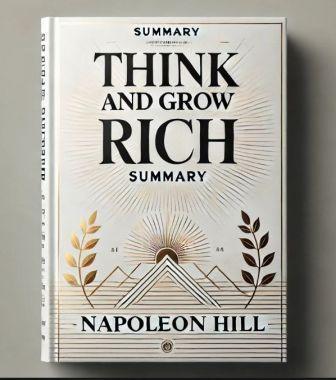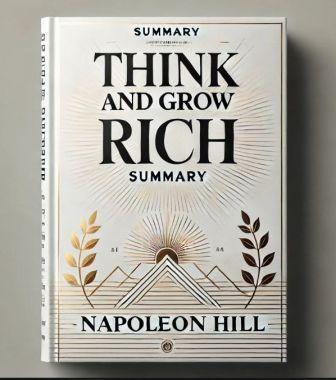
Think and Grow Rich Summary PDF Free Download
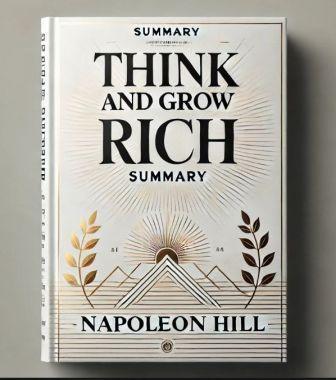
What if you could unlock the secrets to wealth and success in just minutes? Now you can with this powerful Think and Grow Rich summary PDF.
We’ve distilled the life-changing lessons, proven principles, and actionable strategies into an easy-to-read PDF designed to help you:
✅ Master the mindset of success
✅ Turn your goals into reality with proven steps
✅ Overcome obstacles and unlock your full potential
This Think and Grow Rich summary is your shortcut to financial freedom and personal achievement—without spending hours reading the full book.
Ready to transform your future?
Grab your FREE copy now and start applying these powerful principles today! Don’t miss out—success is just one click away.
Think and Grow Rich Summary PDF FREE Download
Get your own copy of the summary, read at your time. It’s FREE

15 Best Faceless YouTube Channel Ideas to Make you Money
Looking for how to start a YouTube business but prefer staying off-camera? Here’s a comprehensive list of faceless YouTube channel ideas along with the necessary skills and tools for each concept.
Whether you’re a master editor or a storytelling genius, there’s something here for everyone.
So, if you have been longing to start a YouTube channel to make money and you are asking: what YouTube channel should I start or which YouTube niche is the most profitable, here is my answer.
Starting a YouTube channel is just like starting a business except you are just doing it for fun. So, I will advice you start a channel in the area you have interest.
Managing a YouTube channel is HARD WORK, just like any other business. You need consistency and hard work to be able to grow a channel that will make you money. A lot of people who are putting in the work are making lots of money on YouTube EVERYDAY and you can too.
Listed below are popular faceless YouTube channel ideas, how you can start and the tools you need to make the job easier.
So, check them out and get inspired to start your own channel without ever showing your face!
Table of Contents
Do you Want to Grow Your YouTube Channel Faster?
Add your name and email address below to download our Fast YouTube Growth checklist for FREE
Benefits of a Faceless YouTube Channel
- Creating a faceless channel is hassle-free!
- You’ll save on expensive equipment like cameras, lights, and microphones.
- No need to fret about camera shyness!
- You can steer clear of unwanted attention from family, friends, and colleagues
Faceless YouTube Channel Ideas
What is the best niche for a faceless YouTube channel? Listed below are the most popular niches. So, pick one that most interests you and hit the ground running.
Motivational YouTube Video Channel
Provide videos of inspiring quotes, inspiring speeches etc.
Here are a list of motivational faceless YouTube video content ideas:
1. A channel dedicated to delivering daily doses of inspiration, motivation, and positivity through uplifting quotes, stories of success, motivational interviews, and actionable advice to pursue their dreams fearlessly and encouraging messages.
2. Start a channel that empowers viewers to transform their lives and reach their full potential with a channel that offers tools and resources for personal growth, self-improvement, and empowerment.
3. You may also start a channel that focuses on the power of mindset and explore topics such as growth mindset, resilience, self-belief, and overcoming obstacles to unlock personal and professional success.
Example of a faceless motivational YouTube channel:
Channel by: BenLionelScott | Subscribers: 3.15M | 72M Views
How to Earn Money with motivational YouTube channels:
1. Affiliate marketing: Recommend personal development books in your video description and add your affiliate link
2. YouTube ads: Allow YouTube to run ads on your channel when your channel gets enough subscribers and views.
3. Sell your products: Add a link to your related product to the video description.
Cooking or Recipe YouTube channels
faceless YouTube channel dedicated to bringing delicious recipes and cooking techniques to food enthusiasts without the need for on-camera appearances. This channel focuses on high-quality visuals and clear, concise instructions to make cooking accessible and enjoyable for everyone.
Content Format:
Recipe Demonstrations:
- Step-by-step walkthroughs of various recipes, from simple weeknight dinners to elaborate holiday feasts.
- Focus on close-up shots of ingredients, cooking processes, and final dishes to ensure viewers can easily follow along.
Cooking Tips and Techniques:
- Short videos highlighting essential cooking tips and techniques, such as knife skills, cooking methods, and ingredient preparation.
- Use slow-motion and detailed visuals to clearly demonstrate each step.
Themed Cooking Series:
- Create series around specific themes, such as “Quick and Easy Weeknight Meals,” “Healthy Cooking,” “World Cuisine,” or “Baking Basics.”
- Each series can have a playlist for viewers to easily find related content.
Ingredient Spotlights:
- Videos focusing on specific ingredients, showcasing their versatility, preparation methods, and recipe ideas.
- Include fun facts, nutritional information, and storage tips.
Collaborations and Guest Recipes:
- Feature recipes from guest chefs or home cooks, with voiceovers explaining the process.
- Collaborate with other food channels for cross-promotion and diverse content.
Channel by: Hearty & Tasty | Subscribers: 1.33M | 5.5M Views
How to Monetise this kind of channel
1. Affiliate marketing: Recommend kitchen tools, gadgets, and ingredients in your video descriptions. Earn a commission when viewers purchase products through your links.
2. Ad Revenue: Once your channel meets YouTube’s eligibility requirements (1,000 subscribers and 4,000 watch hours in the past 12 months), you can apply for the YouTube Partner Program. This allows you to earn money from ads displayed on your videos.
3. Sell recipe books or cook books, train people on how to cook (live class or online course). Add a link to your course or book on your description and use YouTube to drive traffic to where you are selling it.
Do you Want to Grow Your YouTube Channel Faster?
Add your name and email address below to download our Fast YouTube Growth checklist for FREE
Top 5 or Top 10 YouTube channels
People love watching Top 5 and Top 10 videos which helps them make quick purchase or life decisions.
Whether it’s the Top 5 best mobile games for kids or the Top 10 ways to earn money online, these videos offer an engaging blend of education and entertainment.
Typically, the lists are presented in ascending order to keep viewers hooked, eagerly awaiting the top item.
Channel by: Top 5 Picks | Subscribers: 197k | 57k Views
How to Monetise this kind of channel
1. Affiliate marketing: Recommend the products in your top picks and add your affiliate link in the video description.
You earn commission when someone clicks on those links and buy the product.
2. Google Adsense: Enable YouTube ads to earn revenue from ads when people watch your channel content.
Folk Tale/Story YouTube Channels
Dive into the myths, legends, and folklore from cultures around the world, unraveling the stories behind ancient myths, legendary creatures, and mythical heroes.
The channel will blend storytelling, illustrations, and cultural analysis to explore the timeless themes found in folklore.
Content Format:
1. Regional Folklore Showcase: Explore the diverse folklore traditions of different regions across Africa, from West African Yoruba myths to East African Maasai legends and Southern African San stories.
Highlight the unique characteristics and storytelling styles of each culture.
2. Ancestral Spirits and Deities: Introduce viewers to the pantheon of African gods, goddesses, and spirits worshipped in traditional religions.
Share myths and stories that depict their powers, attributes, and interactions with humans.
3. Animal Fables and Moral Tales: Retell classic African animal fables and moral tales featuring clever animals like the hare, the tortoise, and the cunning spider Anansi.
Uncover the moral lessons and cultural values embedded in these timeless stories.
4. Epic Hero Journeys: Narrate epic hero journeys and quest narratives from African mythology, featuring legendary figures such as Sundiata Keita of Mali, Queen Makeda of Sheba, or the trickster god Eshu.
Follow their adventures and trials as they confront challenges and foes.
5. Creation Stories and Origin Myths: Share creation stories and origin myths from African cultures, exploring the cosmological beliefs and mythological narratives that explain the origins of the universe, humanity, and natural phenomena.
6. Supernatural Beings and Creatures: Unravel the mysteries of African folklore by introducing viewers to a variety of supernatural beings and mythical creatures, including shape-shifters, water spirits, forest guardians, and ancestral ghosts.
7. Cultural Festivals and Traditions: Spotlight cultural festivals, rituals, and storytelling traditions from different African communities, such as the storytelling festivals of the Dogon people in Mali or the masquerade performances of the Igbo people in Nigeria.
8. Contemporary Adaptations: Showcase modern interpretations and adaptations of African myths and legends in literature, art, film, and popular culture.
Discuss how ancient stories continue to inspire and influence contemporary storytelling.
Channel by: African Folktales | Subscribers: 4.13k | 123k Views
How to Monetise this kind of channel
1. Affiliate marketing: Recommend story books books
2. Google Adsense: Allow YouTube to run ads on your channel
3. Sell story books.
Do you Want to Grow Your YouTube Channel Faster?
Add your name and email address below to download our Fast YouTube Growth checklist for FREE
Productivity Hacks YouTube Channels
Start a YouTube channel dedicated to helping viewers optimize their time, enhance their efficiency, and achieve their goals through practical productivity hacks and strategies.
The channel offers valuable tips, tools, and techniques to boost productivity in both personal and professional life.
Content Format:
Tutorial Videos:
- Step-by-step guides on using productivity tools and apps (e.g., Trello, Notion, Todoist).
- Detailed walkthroughs on setting up productivity systems like GTD (Getting Things Done) or the Pomodoro Technique.
Listicles and Tips:
- Top 10 productivity hacks for students, professionals, or entrepreneurs.
- Quick tips for managing time, reducing distractions, and staying focused.
Deep Dives and Case Studies:
- In-depth analysis of productivity methods and frameworks.
- Case studies of successful people and how they manage their time.
Animated Explainers:
- Short, engaging animations explaining complex productivity concepts.
- Visual storytelling to illustrate the benefits of different productivity techniques.
Routine and Workflow Showcases:
- Examples of effective daily routines and workflows.
- “A Day in the Life” style videos showcasing productive habits.
Interviews and Collaborations:
- Interviews with productivity experts and thought leaders.
- Collaborative videos with other productivity-focused YouTubers.
Channel by: Iman Gadzhi | Subscribers: 4.83 M | 1 M Views
How to Monetise this kind of channel
1. Affiliate marketing: Partner with companies that offer productivity tools and apps (e.g., Trello, Notion, Todoist). Share affiliate links in your video descriptions and earn commissions on sales generated through your links.
2. Enable Monetization: Once your channel meets YouTube’s Partner Program requirements (1,000 subscribers and 4,000 watch hours in the past 12 months), you can enable monetization to start earning from ads.
3. Sponsorships and Brand Deals: Collaborate with brands to create sponsored videos where you highlight their products or services. Ensure the brands align with your channel’s focus on productivity.
4. Branded Merchandise: Create and sell branded merchandise such as productivity planners, notebooks, calendars, and motivational posters. Use platforms like Teespring, Spreadshirt, Etsy or Merch by Amazon.
5. Digital Products: Sell digital products like printable productivity worksheets, templates, and eBooks. Use platforms like Gumroad or Amazon for digital downloads.
6. Create Courses: Develop online courses or workshops on productivity strategies and techniques. Use platforms like Udemy, Teachable, or Skillshare to host and sell your courses.
7. YouTube Memberships: Enable channel memberships where subscribers can pay a monthly fee for exclusive content, early access to videos, behind-the-scenes footage, and other perks.
8. Personal Coaching: Offer one-on-one productivity coaching sessions, helping clients improve their time management, organization, and efficiency.
Do you Want to Grow Your YouTube Channel Faster?
Add your name and email address below to download our Fast YouTube Growth checklist for FREE
DIY (Do it yourself) Tutorial Channel
Create inspiring do-it-yourself (DIY) tutorials. From crafting and home decor to fashion and beauty, this channel offers step-by-step guides and innovative ideas for viewers to unleash their creativity and transform ordinary materials into extraordinary works of art.
Content Format:
1. Crafting Tutorials: Explore a wide range of crafting projects, including paper crafts, scrapbooking, knitting, crochet, sewing, and more.
Each tutorial provides detailed instructions, tips, and techniques for creating beautiful handmade items.
2. Home Decor DIYs: Revamp your living space with DIY home decor projects, such as wall art, decorative pillows, furniture makeovers, and seasonal decorations.
Learn how to personalize your home with style and flair on a budget.
3. Fashion and Accessories: Elevate your wardrobe with DIY fashion and accessory tutorials, including clothing alterations, jewellery making, handbag customization, and shoe embellishments.
Express your unique sense of style with handmade fashion statements.
4. Upcycling and Recycling: Embrace sustainability and creativity with upcycling and recycling projects that transform everyday objects into new and useful creations.
Discover innovative ways to repurpose old materials and reduce waste.
5. DIY Gifts and Greeting Cards: Show your loved ones you care with heartfelt DIY gifts and handmade greeting cards for every occasion.
Get inspired by personalized gift ideas and creative card-making techniques.
6. Beauty and Self-Care DIYs: Treat yourself to DIY beauty and self-care tutorials, including homemade skincare products, natural cosmetics, bath bombs, and aromatherapy candles.
Pamper yourself with luxurious spa treatments at home.
7. Holiday and Seasonal Crafts: Celebrate holidays and seasons with festive DIY projects and decorations, from Halloween costumes and Christmas ornaments to Easter crafts and summer party essentials.
Bring joy and cheer to every occasion.
8. DIY Organization Solutions: Streamline your life with DIY organization solutions for your home, office, and personal life.
Learn how to declutter, organize, and optimize your space with creative storage hacks and organizing tips.
Channel by: Digital Sat Pro | Subscribers: 196k | 1.3M Views
How to Monetise this kind of channel
1. Affiliate marketing: Recommend courses of where to buy raw materials for the crafts
2. Google adsense: Allow Youtube to run ads on your channel
3. Sell finished craft products and courses on how to make more crafts
Product Tutorial Videos
Are you passionate about tech and gadgets but prefer staying behind the camera?
Start a YouTube channel dedicated to providing detailed and easy-to-follow tutorials on various tech products, gadgets, and software.
The aim is to help viewers understand and utilize their tech products to their fullest potential through step-by-step guides and comprehensive reviews.
Content Format:
Unboxing and Setup Guides:
- Unboxing Videos: Showcase what’s inside the box and give first impressions.
- Setup Guides: Provide step-by-step instructions to help viewers get started with their new products.
How-To Tutorials:
- Feature Tutorials: In-depth guides on specific features of tech products.
- Tips and Tricks: Share lesser-known tips to maximize product functionality.
Product Comparisons:
- Side-by-Side Comparisons: Compare similar products, highlighting their pros and cons.
- Recommendation Videos: Suggest products based on specific user needs and preferences.
Software Walkthroughs:
- Interface Tours: Walk viewers through software interfaces, explaining functionalities.
- Task Tutorials: Guide viewers on how to complete specific tasks using the software.
Troubleshooting and FAQs:
- Common Issues: Identify common issues and provide troubleshooting steps.
- FAQ Videos: Answer frequently asked questions and offer practical solutions.
Channel by: Sassyin Korea | Subscribers: 430K | 9.6M Views
How to Monetise this kind of channel
1. Affiliate marketing: Recommend the product you are unboxing by adding your affiliate link for the product in the video description
2. Google Adsense: Enable Google ads on your YouTube channel.
Do you Want to Grow Your YouTube Channel Faster?
Add your name and email address below to download our Fast YouTube Growth checklist for FREE
Gaming Video channel
If you love gaming and would like to make money off your skill, create a YouTube channel dedicated to providing high-quality gaming content without the need for on-camera appearances.
The channel focuses on gameplay, tutorials, reviews, and tips to help viewers improve their gaming skills and stay updated with the latest in the gaming world.
Content Format:
Gameplay Walkthroughs:
- Full Game Playthroughs: Record and commentate entire game playthroughs, providing tips and strategies.
- Level Guides: Create detailed guides for specific levels or missions.
Game Reviews and First Impressions:
- Game Reviews: Provide in-depth reviews of newly released games, discussing gameplay, graphics, story, and overall experience.
- First Impressions: Share your initial thoughts and reactions to newly released or upcoming games.
Tips and Tricks:
- Strategy Guides: Offer advanced strategies and tips for popular games.
- Top 10 Lists: Create lists of the best weapons, characters, strategies, etc.
Let’s Play Series:
- Series Playthroughs: Record episodic content of popular games, with engaging commentary.
- Collaborative Let’s Plays: Collaborate with other gamers for multiplayer game content.
News and Updates:
- Gaming News: Cover the latest news and updates in the gaming industry.
- Patch Notes and Updates: Discuss new game patches, updates, and what they mean for players.
Channel by: Anshu Bisht| Subscribers: 6.01M | 642.992M Views (in just 10 hours!)
How to Monetise this kind of channel
1. YouTube Partner Program
- Enable Monetization: Once your channel meets YouTube’s Partner Program requirements (1,000 subscribers and 4,000 watch hours in the past 12 months), you can enable monetization to start earning from ads.
2. Super Chat and Super Stickers
- Live Streaming: During live streams, viewers can purchase Super Chats and Super Stickers to highlight their messages and support your channel. This feature is available once your channel is monetized and you’re live streaming.
3. Channel Memberships
- Membership Tiers: Offer channel memberships where subscribers can pay a monthly fee for exclusive content, badges, emojis, and other perks. Create different membership tiers with varying levels of benefits.
4. Affiliate Marketing
- Gaming Gear and Accessories: Partner with companies that sell gaming gear, accessories, or digital products. Share affiliate links in your video descriptions and earn commissions on sales generated through your links.
- Game Sales: Promote game sales through affiliate programs from platforms like Amazon, Green Man Gaming, or Humble Bundle.
5. Sponsorships and Brand Deals
- Sponsored Content: Collaborate with brands to create sponsored videos where you highlight their products or services. Ensure the brands align with your channel’s focus on gaming.
6. Merchandise Sales
- Branded Merchandise: Create and sell branded merchandise such as t-shirts, hoodies, posters, and mugs. Use platforms like Teespring, Spreadshirt, or Merch by Amazon.
- Digital Products: Sell digital products like game guides, eBooks, or custom game mods. Use platforms like Gumroad or Etsy for digital downloads.
7. Online Courses and Coaching
- Gaming Skills: Offer online courses or one-on-one coaching sessions to help others improve their gaming skills. Use platforms like Udemy, Teachable, or Skillshare to host and sell your courses.
- Streaming Setup: Provide coaching on how to set up and grow a gaming channel or stream effectively.
9. Ad Revenue from Other Platforms
- Repurpose Content: Share your YouTube videos on other monetizable platforms like Facebook, Instagram (IGTV), and LinkedIn to generate additional ad revenue.
- Short-Form Content: Create and monetize shorter gaming tips on platforms like TikTok and Instagram Reels.
10. Gaming Tournaments and Events
- Host Tournaments: Organize and host online gaming tournaments with entry fees and sponsorships. This can also drive traffic to your channel.
- Live Events: Host live gaming events or participate in gaming expos and conferences, monetizing through ticket sales, sponsorships, and live streaming donations.
Do you Want to Grow Your YouTube Channel Faster?
Add your name and email address below to download our Fast YouTube Growth checklist for FREE
Language Learning Video channel
Create a YouTube channel dedicated to teaching languages like English, French, Spanish, Igbo or other local language through engaging, high-quality content that helps viewers learn and practice new languages effectively.
The channel offers lessons, tips, and resources for learners of all levels, from beginners to advanced.
Content Format:
Grammar and Vocabulary Lessons:
- Short Lessons: Create short, focused videos on specific grammar rules or vocabulary themes (e.g., colors, food, travel).
- Thematic Vocabulary: Videos covering vocabulary for specific situations or themes, such as traveling, shopping, or business.
Pronunciation Guides:
- Phonetic Lessons: Teach the correct pronunciation of letters, words, and phrases using phonetic symbols and examples.
- Accent Training: Provide tips and exercises to help learners acquire the correct accent and intonation.
Conversation Practice:
- Dialogues: Record dialogues for different scenarios (e.g., at a restaurant, meeting someone new) and break them down for learners.
- Role-Playing Exercises: Offer role-playing scenarios that viewers can practice along with.
Cultural Insights:
- Cultural Context: Create videos explaining cultural nuances and customs associated with the language being taught.
- Language in Context: Show how the language is used in real-life situations, including idiomatic expressions and slang.
Language Learning Tips:
- Study Tips: Share effective study techniques and resources for language learning.
- Motivational Videos: Encourage learners to stay motivated and consistent in their language studies.
Channel by: Kids Songs & Nursery rhymes| Subscribers: 1.37M | 55M Views
How to Monetise this kind of channel
1. Affiliate marketing: Partner with companies that offer language learning tools and resources (e.g., language apps, textbooks, online courses).
Share affiliate links in your video descriptions and earn commissions on sales generated through your links.
Books and Resources Promote language learning books and resources available on platforms like Amazon.
2. YouTube Ad Revenue: Enable Monetization: Once your channel meets YouTube’s Partner Program requirements
3. Sponsored Content: Collaborate with brands to create sponsored videos where you highlight their language learning products or services.
4. Create Courses: Develop online courses on specific aspects of language learning (e.g., grammar, conversation skills). Use platforms like Udemy, Teachable, or Skillshare to host and sell your courses.
5. Private Tutoring: Offer one-on-one or group tutoring sessions for personalized language learning experiences.
Relaxing/Study & Meditation channel
Create a channel dedicated to helping viewers find inner peace, relaxation, and mindfulness through guided meditation and calming content.
With a variety of meditation practices, relaxation techniques, and mindfulness exercises, this channel aims to promote mental well-being, reduce stress, and enhance overall quality of life.
Content Format:
1. Guided Meditation Sessions: Offer a variety of guided meditation sessions tailored to different needs and preferences, including mindfulness meditation, body scan meditation, loving-kindness meditation, and visualization exercises.
Each session provides soothing narration and gentle guidance to help viewers relax, focus, and unwind.
2. Breathing Exercises: Introduce viewers to various breathing techniques and pranayama exercises to promote relaxation, reduce anxiety, and improve focus and concentration.
Teach techniques such as deep breathing, alternate nostril breathing, and box breathing for stress relief and emotional balance.
3. Progressive Muscle Relaxation: Guide viewers through progressive muscle relaxation exercises to release tension, reduce muscle stiffness, and promote physical and mental relaxation.
Help viewers cultivate body awareness and learn to let go of stress and tension.
4. Nature Sounds and Relaxation Music: Provide immersive experiences with nature sounds, ambient music, and calming soundscapes to create a tranquil atmosphere for meditation and relaxation.
Curate playlists of soothing sounds, including ocean waves, forest birdsong, rainfall, and gentle instrumental music.
5. Mindfulness Practices: Teach viewers mindfulness techniques and practices for cultivating present-moment awareness, acceptance, and non-judgmental observation.
Offer mindfulness exercises such as mindful breathing, mindful walking, and body scan meditation to enhance mindfulness skills and cultivate inner peace.
6. Stress Reduction Tips: Share practical tips, strategies, and lifestyle changes for managing stress and promoting mental well-being in daily life.
Offer advice on stress management, time management, self-care practices, and creating healthy boundaries to support viewers in achieving balance and resilience.
7. Sleep Meditation and Relaxation: Provide guided meditation sessions and relaxation techniques specifically designed to promote restful sleep and alleviate insomnia.
Help viewers unwind before bedtime, quiet the mind, and prepare for a peaceful and rejuvenating night’s sleep.
8. Gratitude and Affirmations: Foster a positive mindset and emotional well-being with gratitude practices and positive affirmations.
Lead viewers through gratitude meditation exercises and affirmations to cultivate feelings of gratitude, optimism, and self-love.
Channel by: Goodful | Subscribers: 1.5M | 23M Views
How to Monetise this kind of channel
1. Affiliate marketing: Recommend meditation tools
2. Google Adsense: Allow YouTube to run ads on your channel
3. Sell meditation courses, Apps etc.
Do you Want to Grow Your YouTube Channel Faster?
Add your name and email address below to download our Fast YouTube Growth checklist for FREE
Historical Story Video channel
Dive into captivating stories from history, bringing to life forgotten events, unsung heroes, and intriguing mysteries from various time periods and cultures. The channel will blend narration, animations, and archival footage to create immersive historical narratives.
Content Format:
1. Mini Documentaries: Produce short, well-researched documentaries focusing on specific historical events, figures, or periods.
Each video will combine narration with visual elements such as maps, timelines, and animated reconstructions to engage viewers.
2.Historical Mysteries: Explore unsolved mysteries and enigmatic events from history, presenting different theories and evidence.
Invite viewers to speculate and discuss their own interpretations in the comments section.
3. Behind-the-Scenes: Provide behind-the-scenes looks at historical discoveries, archaeological excavations, and museum exhibits.
Collaborate with experts to showcase rare artifacts and reveal the stories behind their preservation.
4. Historical Analysis: Offer analytical breakdowns of iconic moments in history, examining their significance and impact on society.
Use infographics, charts, and diagrams to illustrate key points and facilitate understanding.
5. Personal Stories: Highlight the untold stories of ordinary individuals who lived through extraordinary times, shedding light on their struggles, triumphs, and contributions to history.
6. Historical Debates: Host debates or panel discussions featuring historians, scholars, and enthusiasts debating controversial topics or interpreting conflicting accounts from history.
7. Interactive Quizzes: Create interactive quizzes or trivia games based on historical facts and trivia. Encourage viewer participation and offer rewards or shout outs for correct answers.
8. Virtual Tours: Take viewers on virtual tours of historical landmarks, ancient ruins, and cultural heritage sites around the world. Use 360-degree footage and immersive VR technology to transport viewers to distant locales.
Channel by: Unavailing the Scriptures | Subscribers: 200k | 2.2M Views
How to Monetise this kind of channel
1. Affiliate marketing: Recommend history books
2. Google adsense: Allow Youtube to run ads on your channel
3. Sell history books, courses etc.
Echos of the Past (historical) Videos
Explore the echoes of history through immersive storytelling, focusing on lesser-known historical events, forgotten civilizations, and cultural phenomena.
The channel will utilize a combination of narration, animations, and expert interviews to bring the past to life.
Content Format:
1. Lost Civilizations: Investigate ancient civilizations and cultures that have vanished from the historical record, such as the Indus Valley Civilization, the Minoans, or the Olmecs.
Use archaeological discoveries and expert insights to reconstruct their stories.
2. Epic Journeys: Trace the footsteps of famous explorers, adventurers, and travellers throughout history, from Marco Polo’s journey along the Silk Road to Ernest Shackleton’s Antarctic expedition.
Combine historical reenactments with maps and animations to illustrate their voyages.
5. Revolutionary Ideas: Examine pivotal moments in the history of ideas, such as the Scientific Revolution, the Enlightenment, or the Industrial Revolution.
Explore the impact of intellectual movements on society and culture.
4. Forgotten Heroes: Spotlight overlooked figures and marginalized voices from history, including women, minorities, and indigenous peoples.
Highlight their contributions to shaping historical events and challenging the status quo.
5. Historical Fashion: Explore the evolution of fashion and clothing styles throughout history, from ancient garments to modern trends.
Use archival images, illustrations, and fashion plates to showcase changing sartorial tastes.
6. Historical Cuisine: Delve into the culinary traditions of different cultures and time periods, uncovering recipes, cooking techniques, and food rituals from antiquity to the present day.
Recreate historical dishes and explore their cultural significance.
7. Iconic Artifacts: Showcase iconic artifacts and relics from history, from the Rosetta Stone to the Terracotta Army.
Discuss their historical context, significance, and preservation efforts.
8. Time Travel Experiments: Imagine hypothetical scenarios or alternate histories based on pivotal moments in the past.
Use speculative fiction and creative storytelling to explore “what-if” scenarios and their potential ramifications.
Channel by: Black Journals | Subscribers: 438k | 827k Views
How to Monetise this kind of channel
1. Affiliate marketing: Recommend history books
2. Google adsense: Allow Youtube to run ads on your channel
3. Sell history books, courses etc.
Do you Want to Grow Your YouTube Channel Faster?
Add your name and email address below to download our Fast YouTube Growth checklist for FREE
Science Experiment Video Channel
If you love science, you can start a YouTube channel dedicated to showcasing fun and educational science experiments.
The channel aims to make science accessible and engaging for all ages by demonstrating experiments that viewers can try at home or in the classroom.
Content Format:
Simple Science Experiments:
- Short Demonstrations: Create concise videos (3-5 minutes) demonstrating simple science experiments that viewers can replicate at home using common household items.
- Step-by-Step Instructions: Provide clear, step-by-step instructions with text overlays and visual demonstrations.
Thematic Experiment Series:
- Physics, Chemistry, Biology: Develop series focusing on different branches of science (e.g., physics experiments, chemistry reactions, biology projects).
- Seasonal Experiments: Share experiments related to seasons or holidays (e.g., winter-themed experiments, Halloween science projects).
In-Depth Science Explanations:
- How It Works: Offer detailed explanations of the scientific principles behind each experiment, using animations and diagrams.
- Real-Life Applications: Discuss real-life applications and implications of the science demonstrated in the experiments.
Challenge Videos:
- Experiment Challenges: Create challenge videos where you attempt more complex or large-scale experiments.
- Viewer Challenges: Encourage viewers to try experiments and share their results, featuring the best ones in your videos.
Collaborations and Guest Appearances:
- Guest Scientists: Collaborate with other science educators or enthusiasts to demonstrate experiments.
- Interactive Live Streams: Host live streams where you perform experiments in real-time and answer viewer questions.
Channel by: Nat Geo Kids | Subscribers: 1.i6M | 281K Views
How to Monetise this kind of channel
1. Enable YouTube ads revenue
2. Affiliate marketing: Partner with companies that sell science experiment kits and educational materials. Share affiliate links in your video descriptions
3. Sponsored Content: Collaborate with educational brands and science-related companies to create sponsored videos where you highlight their products and services.
Life Hacks Video Channel
Start a YouTube channel dedicated to sharing simple yet effective life hacks that can make everyday tasks easier, save time, and enhance productivity.
The channel covers a wide range of topics, from household tips and DIY projects to tech tricks and productivity hacks.
Content Format:
Quick Tips and Tricks:
- Short Videos: Create concise videos focusing on one or two hacks per video (1-3 minutes long).
- Step-by-Step Guides: Provide clear, step-by-step instructions with text overlays and visual demonstrations.
Compilation Videos:
- Top 5/Top 10 Lists: Curate lists of the best hacks for specific categories (e.g., Top 10 Kitchen Hacks, Top 5 Travel Hacks).
- Thematic Compilations: Group hacks by themes such as “Eco-Friendly Hacks” or “Tech Hacks.”
DIY Projects:
- Detailed Tutorials: Offer in-depth tutorials for DIY projects, showcasing materials needed and step-by-step processes.
- Before and After: Show the results of the hacks with before and after footage.
Productivity and Organization Hacks:
- Workplace Hacks: Share tips for improving productivity and organization at work or while studying.
- Home Organization: Offer hacks for decluttering and organizing different areas of the home.
Seasonal and Holiday Hacks:
- Seasonal Tips: Provide hacks related to specific seasons (e.g., summer cooling hacks, winter home maintenance tips).
- Holiday Hacks: Share tips for making holidays more enjoyable and less stressful (e.g., gift wrapping hacks, holiday decoration tips).
Channel by: 5 Minutes Crafts | Subscribers: 80.6M | 5.4M Views
How to Monetise this kind of channel
1. YouTube ads revenue
2. Affiliate marketing: Partner with companies that sell products related to your hacks (e.g., kitchen gadgets, DIY tools).
Share affiliate links in your video descriptions and earn commissions on sales generated through your links.
3. DIY Kits: Sell DIY kits related to your hacks (e.g., home organization kits, DIY project kits).
Ambient Nature Soundscapes Video Channel
Create a channel focused on providing high-quality ambient nature soundscapes to help viewers relax, meditate, study, or sleep.
The channel will feature a wide variety of natural environments, such as forests, rivers, beaches, and rain forests, each with its unique soundscape.
Content Format:
1. Nature Scenes: Record high-definition video footage of various natural landscapes without any human presence.
Focus on capturing the sights and sounds of each environment, including rustling leaves, flowing water, bird songs, and gentle breezes.
2. Soundscapes: Extract and enhance the audio from the video recordings to create immersive 3D soundscapes.
Use binaural recording techniques to simulate a realistic audio experience, allowing viewers to feel like they’re truly immersed in nature.
3. Seasonal Themes: Curate seasonal playlists featuring nature scenes and soundscapes specific to each season.
For example, showcase vibrant autumn foliage, serene winter snowscapes, or blooming spring gardens.
4. Special Events: Livestream special events such as meteor showers, lunar eclipses, or sunrise/sunset time lapses accompanied by ambient soundscapes.
Engage with the audience during these live events through chat or Q&A sessions.
5. Collaborations: Partner with environmental organizations, national parks, or wildlife sanctuaries to feature exclusive footage of protected natural habitats.
Raise awareness about conservation efforts and promote responsible eco-tourism.
6. Guided Meditations: Occasionally release guided meditation videos that combine calming visuals with soothing narration or mindfulness exercises.
Help viewers achieve a state of relaxation and inner peace through nature-inspired meditation sessions.
7. Community Engagement: Encourage viewer participation by inviting them to submit their own nature recordings or share their favourite outdoor experiences.
Feature user-generated content in compilation videos or community spotlights to foster a sense of community.
8. Educational Content: Offer educational videos exploring the science behind natural phenomena, wildlife behaviour, or ecological systems.
Collaborate with experts in fields such as ecology, biology, or environmental science to provide accurate and informative content.
Channel by: The Guild of Ambience | Subscribers: 570k | 18M Views
How to Monetise this kind of channel
1. Affiliate marketing: Recommend meditation tools like ear plugs Or guided meditation Apps
2. Google adsense: Allow Youtube to run ads on your channel
3. Sell your meditation Apps or courses on guided meditation or related things.
Do you Want to Grow Your YouTube Channel Faster?
Add your name and email address below to download our Fast YouTube Growth checklist for FREE
YouTube Tools for creatives
People keep asking: what is the best tool to make faceless YouTube videos? What is needed to start a faceless YouTube channel? Which AI tool is best for YouTube videos?
I believe you maybe asking the same questions too. To create a faceless YouTube video, you will need the following:
- Channel Art or channel cover picture
- Channel profile picture
- Thumbnail for each video. An attractive image you use for each video to make it stand out on YouTube
- The video script
- Voice over or video audio
- Images or video clips
- Keyword research so your video is easily found
- Channel analysis so you know what’s working, what’s not and optimise your channel for growth.
So, here are tools you will need to start and grow a faceless YouTube channel with ease:
1. ChatGPT by Open AI:
ChatGPT helps you to write your video scripts without stress. All you need is the right prompt. If for example you want to create a motivational video, your prompt could be:
“I want to create a motivational video for my YouTube channel based on this quote [add the quote]. Write the video script for me. Make it very emotional and persuasive.”
2. Eleven Lab AI text to voice platform:
Eleven Lab helps you to convert text to a natural human voice. All you need to do is copy your text or script that you just generated with ChatGPT or the one you wrote yourself and paste it in Eleven Lab.
It converts the text to a human voice in seconds and you download it as the voice for your video.
No need to waste time doing a voice over yourself or paying someone huge amount of money to do it except you prefer to use your own voice.
3. Leonard AI Picture generation:
With Leonard AI, you can generate any kind of picture including realistic painting in seconds for your YouTube videos.
I generated the image below with Leonard AI using this prompt:
“Create an image of a child sitting in front of a hut looking happy in an African village setting. Realistic painting.”
You can generate any kind of image with Leonard AI by telling it exactly what you want created in form of a prompt.

4. Canva:
You can use canva to create your YouTube thumbnails, channel art and channel profile picture yourself.
If you don’t want to create these things yourself or you don’t have the time to create professional thumbnails that make your videos stand out from the crowd with higher click through rates, you should consider using freelance designers at Fiverr who have mastered the art so you can focus on finding the right content and growing your channel.
Pexels:
5. Pexels offers free stock pictures and videos you can use to create your videos. If you prefer not to generate your video with AI, or create your videos yourself, you can download free images or videos and use them to create your YouTube videos.
6. Capcut:
Capcut is a video editor.You can download it from Google play store.
This is what you need to put the videos or images and voice together to get your full YouTube.
7. Genmo AI:
Genmo ai helps you to create stunning videos from text or images with AI
7. VidiQ:
VidiQ will analyse your YouTube channel data and tells you what you need to do to grow your Youtube channel. It will even show you keywords you should use to outrank your competitors on YouTube.
8. Google Trends:
Use Google trends to find trending keywords people are searching for related to your channel topic and make posts about them to drive more traffic to your channel.
You can also use Google keyword search tool called Google keyword planner to find keywords you will add to your video descriptions to gain more traffic. Google keyword planner and Google Trends are free tools.
SEMrush is also a great tool for researching and finding keywords that will help rank your YouTube channel and help people find your channel faster.
SEMrush has a free plan, but if you want more premium resources, you will need to pay, but you can start with the free plan.
9. Screen recording software
If your YouTube channel is focused on creating tutorial videos (like a video about how to use a tool), you will need a screen recorder like screencast to record your screen.
10. Camera
You will need a camera if you want to record a DIY (do it yourself ) video like how to make a dress etc. You won’t need to show your face as your camera will focus only on what you are teaching.
You can use a digital camera or your phone camera for this purpose. To record a professional video, you will need a tripod stand, a ring light for clear videos and microphone for clear audio.
11. Audacity: Audacity is a free audio editing software that will help you make quality audio for your YouTube videos.
12. Animation tool: if you plan to create a historical YouTube channel, you will need an animation tool like Animaker,Adobe animate,Blender, Moho to help with explaining what has happened in the past.
13. Gaming Recording Equipment: (If your channel is focused on gaming)
- Capture Card: Elgato Game Capture HD60 S+ or similar for recording console gameplay.
- Screen Recording Software: OBS Studio, Fraps, or ShadowPlay for recording PC gameplay.
Audio Equipment:
- Microphone: High-quality microphone (e.g., Blue Yeti, Rode NT-USB) for clear commentary.
- Headset: Good gaming headset for immersive sound and communication.
Skills you need to create and run a successful faceless YouTube channel and make money

1. Script writing with AI prompts
How to write prompts that will help you in crafting compelling and relatable scripts that resonate with viewers.
2. Basic video editing
Basic knowledge of video editing using Capcut or any other video editing software or App.
3. Research and content curation
Ability to research and curate inspiring stories, quotes, and success strategies. Keeping up-to-date with trends and topics that interest your audience.
4. Basic design skills
Basic design skills to create engaging thumbnails, overlays, and other visual elements. Familiarity with design software like Adobe Photoshop, Illustrator, or Canva.
5. YouTube SEO (search engine optimisation)
Knowledge of YouTube SEO to optimize video titles, descriptions, and tags for better visibility.
6. Video recording skills
You will need video recording skill if your Youtube channel is about DIY videos or any kind of video that you can’t get using AI tools.
7. Social media management & marketing
Understand how to use social media marketing to promote your videos and grow your audience. Know how to manage and engage with your audience across various social media platforms. Build a community and foster relationships with viewers and followers.
8. Empathy and emotional intelligence
Understand your audience’s emotions and needs. Connect with viewers on a deeper level and provide genuine support and encouragement.
9. Consistency and Time Management
Consistently produce and upload content to build and maintain audience interest.
Without consistency, you won’t make much money with your YouTube channel.
You also need effective time management to balance content creation with other responsibilities.
10. Analytical Skills
Use YouTube Analytics tool like VidiQ to track performance and understand viewer behaviour.
Analysing your channel data helps you in making data-driven decisions to improve content and grow your channel
11. Stay adaptable
Stay adaptable and open to learning new skills and techniques.
Continuously improve your content based on feedback and changing trends.
12.Interviewing:
If you want to create a historical YouTube channel, you will need the ability to conduct interviews with historians, archaeologists, and other experts to provide insights and context for historical topics.
Conclusion
There you have it. I hope you have been able to get an idea from our list of faceless YouTube channel ideas.
Creating a faceless YouTube channel offers a unique and accessible way to share your passions, skills, and knowledge without the pressure of being on camera.
Whether you’re delving into history, storytelling, product unboxing, DIY tutorials, meditation, or motivational content, there’s a niche for every interest and talent.
By leveraging the right skills and tools, you can produce high-quality, engaging videos that resonate with your audience and grow your channel.
Embrace the opportunities that come with faceless content creation and start your YouTube journey today, knowing that your creativity and voice can inspire and connect with viewers around the world.
Share this with friends!
Do you Want to Grow Your YouTube Channel Faster?
Add your name and email address below to download our Fast YouTube Growth checklist for FREE
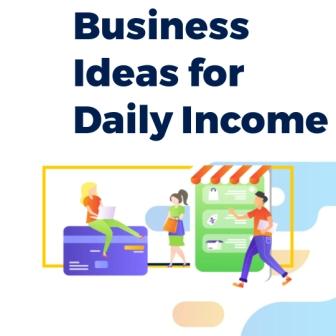
385+ Small Business Ideas in Nigeria – Daily Income
Welcome to our guide to small business ideas in Nigeria, where the possibilities are as boundless as your imagination.
If you are looking for daily income business ideas or most profitable business ideas in Nigeria, this guide is for you.
So, get ready to tap into your passions, unleash your potential, and carve out your own slice of success in the vibrant heart of Africa.
This isn’t just about business; it’s about turning your dreams into reality. Let’s make it happen together.
The best way to find novel business ideas is to brainstorm or think of ways you can satisfy other people’s needs or solve their most pressing problems.
Countless times, people ask: how do I come up with a business idea? How do I find out what business to start? How do I start a business if I don’t have an idea? And they go on and on.
I assume the reason you are reading this post is because you are asking the same or related questions too.
To find business ideas that are capable of disrupting industries, do the following:
1. Ask: is there an easier way?
One way to find a business idea is to ask yourself ,“what task can I make easier?” What makes a business a business, is its ability to solve a customer’s pressing problem or provide for a customer’s needs.
Think of how to create a product that makes a customer’s life easier.
2. Ask: Can I make this more accessible?
There are a lot of products and services that are not easily or readily available in the market to most people who need them.
For example Tosin Eniolorunda, founder of Moniepoint MFB discovered that the traditional banks where not reaching a lot of people especially those in rural or less developed areas.
Millions of people could not have access to banking services. They introduced POS services and spread it into the rural areas faster than the traditional banks could.
They even made it possible for those with just a phone and phone number to access banking services; helping business growth.
3. Ask: What can I improve about this?
There is always something to improve about any product or service that is already in existence.
Think of companies you love their products and imagine how you could improve their delivery process, or take it to a location it does not exist in yet, or make it cheaper for the rest of the masses, or improve the customer experience etc.
Remember, Uber company that is worth billions of dollars today, did not start with an entire new business idea. It just improved on what already existed; taxi business, and made it more accessible and convenient. Uber radically changed the way taxi service business is delivered.
Now, you know how to find a business idea. Below, are a list of business ideas for your inspiration.
Table of Contents

Money Making Agriculture Business Ideas
Discover opportunities in Nigeria’s agricultural sector with our exclusive guide to lucrative business ideas in the agricultural sector.
These ideas are based on products that are in high demand and would help you start a profitable agricultural business in Nigeria.
- Poultry farming (chicken, turkey, and duck)
- Fish farming (tilapia, catfish, and carp)
- Crop cultivation (such as maize, rice, cassava, and vegetables)
- Snail farming
- Pig farming
- Beekeeping and honey production
- Livestock farming (cattle, goats, and sheep)
- Greenhouse farming or growing crops in an enclosed environment. Less land space, more yield.
- Agro-processing (processing agricultural products into value-added goods)
10. Hydroponics (growing crops without soil) and aquaponics farming (growing of fish in a closed environment and feeding hydroponic crops with aquaculture water). - Mushroom cultivation, including exotic varieties like oyster and shiitake mushrooms
- Hydroponic vegetable farming for high-yield, soil-less cultivation
- Snail processing and packaging for export markets
- Organic fertilizer production using composting techniques
- Aloe vera farming for skincare and medicinal products
- Bamboo cultivation for construction materials and eco-friendly products
- Vermicomposting business producing organic fertilizer from earthworms
- Exotic fruit orchard specializing in fruits like dragon fruit, passion fruit, and star fruit
- Medicinal herbs and botanicals cultivation for herbal remedies and supplements
- Agro-tourism farm offering tours, educational workshops, and farm stays to tourists, school children
- Plantain plantation
- Goat dairy farm producing cheese, yogurt, and milk products
- Egg production from chicken and quails
- Organic vegetable subscription box service delivering fresh produce to customers’ doorsteps
- Greenhouse farming of exotic flowers for local and export markets
- Herbs and spices cultivation for culinary and medicinal purposes
- Beekeeping and honey production, including value-added products like beeswax candles and royal jelly
- Indigenous poultry farming, focusing on native chicken breeds for meat and eggs
- Agro-processing facility for turning raw agricultural products into packaged goods, such as fruit jams, sauces, and snacks (coconut chips, plantain chips, packaged dry pap etc.)
- Integrated pest management consultancy offering eco-friendly solutions to farmer

More Agriculture Business Ideas
- Dairy processing plant producing cheeses and dairy products and selling to diary companies
- Agricultural equipment rental services for small-scale farmers
- Plant propagation business specializing in cloning and breeding of high-yield crop varieties and selling to farmers
- Commodity trading consultancy assisting farmers in marketing their produce effectively.
- Soil testing and analysis services to help farmers optimize their soil fertility and crop yields.
- Agricultural insurance brokerage, providing risk management solutions to farmers.
- Organic pest control product manufacturing using natural and eco-friendly ingredients.
- Seedling nursery specializing in high-quality seedlings for various crops and selling to farmers for more yield.
- Agricultural drone services for aerial monitoring, mapping, and crop spraying.
- Livestock feed manufacturing using locally sourced ingredients.
- Soil erosion control and land reclamation services.
- Agricultural biotechnology research and development for crop improvement.
- Farm equipment repair and maintenance services.
- Agricultural waste recycling and bio-energy production. Producing renewable energy from recently living organic materials via fermentation process to produce transportation fuel, heat electricity, cooking gas etc
- Agro-consulting firm providing advisory services on sustainable farming practices and market trends.
- Providing agritourism accommodation, such as farm stays, guesthouses, or eco-lodges.
- Organic fertilizer production using composting methods and organic waste materials and selling to farmers.
- Providing livestock genetics and breeding services for improved animal genetics and productivity.
- Agricultural supply chain management services to optimize logistics and distribution.
- Precision livestock farming technology solutions for monitoring animal health and behaviour.
- Aquaculture consultancy services for sustainable fish farming practices.
- Agricultural education and training centre offering courses, workshops, and certifications for aspiring farmers
- Start a fruit tree plantation like mango, paw paw, cashew, oranges etc.
- Grow bitter kola for the export market. Bitter cola is in hot demand in the export market
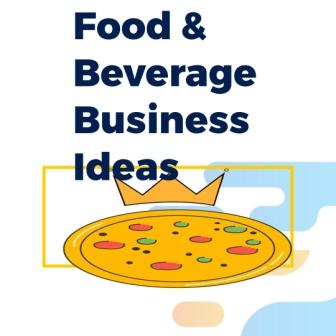
Food and beverage businesses
Most people keep asking: which food business is most profitable? What food items sell fast in Nigeria? What food is easy to sell and so on.
The simple answer is, every food sells as long as there are human beings who eat it.
Here are listed food and beverages business ideas that will make you money.
- Start a restaurant or an eatery
- Fast food joint (such as burger or pizza outlets)
- Food catering services for events and parties
- Bakery and confectionery (including bread, pastries, and cakes)
- Smoothie and juice bar
- Start an ice cream parlour selling different types of ice creams and flavours
- Plantain chips and snacks production
- Bottled water production and distribution
- Tea and coffee shop
- Local delicacies or street food vending like abacha, Akara (bean cake), okpa (bambara nuts flour), chin-chin, moi-moi (beans pudding), snacks
- Pap production
- Kuli-kuli production business
- Speciality food store focusing on organic, health-conscious, or gourmet product
- Spice and seasoning production and packaging
- Fruit and vegetable retail outlet
- Yogurt and smoothie production
- Nutritional supplements and health foods store
- Soup and stew preparation and delivery services for busy mums and bachelors
- Exporting ready made Nigerian Soup and stew to Nigerians living in diaspora
- Catering for corporate events, weddings, and other special occasions
- Online food delivery platform or meal kit service
- Dessert bar or cafe specializing in cakes, pastries, and desserts
- Niche food products such as gluten-free, vegan, or keto-friendly snacks
- Food preservation and packaging business (e.g., dried fruits, pickles, jams)
- Artisanal chocolate or candy making
- Food blogging, vlogging, or social media influencer focusing on culinary content
- Cooking classes and culinary workshop
- Food franchise opportunities with established brands in the Nigerian market
- Food waste recycling and composting services

More Food and Beverage Business Ideas
- Mobile food vending carts for snacks or street food
- Popcorn production in different flavours
- Personal chef
- Cooking classes for kids and newly married women
- Food condiments/grocery store
- Catering equipment rental business
- Become a food influencer on social media or Youtube helping food brands sell their products
- Cookbook author. Author a cook book to help people who don’t know how to cook different dishes
- Restaurant consulting services. Teach restaurant owners how to run successful restaurant business
- Food gift basket business.Put together fruits and snacks, chocolates, cakes etc in baskets and have people buy and use it as gift to others
- Nutrition coach. Teach people about the kind of nutrition they need for a healthy body or to be in shape or to manage sickness like diabetes.
- Start a wine shop or bar
- Delivery only restaurant. Setup a restaurant that cooks and only delivers food to customers to their homes and offices
- Start selling food packaging materials for other brands especially online retailers. You can also offer to help them package it
- Pet food business. Sell food for dogs, cats etc
- Food product branding and design services
- Food wholesaler. Sell wholesale
- Cooking YouTube channel
- Meat processor. Turn large chunks of meat into tiny meats and sell to fast food restaurants and pastry businesses
- Tigernut production and retail business
- Packaged spice production business
- Kunu production and retail business
- Yam flour processing
- Tomato paste production
- Biscuits manufacturing business
- Rice flour milling business and retail to businesses making pastries, noddles etc.
- Provide a food storage facility to farmers for a fee
- Custard production
- Palm oil production and retail or palm oil packaging and retail
- Potato chips production
Want to Start Making Consistent Sales in Your Business?
Gain access to our FREE customer acquisition guide
More Food Business Ideas
- Cassava processing. Process cassava into garri, cassava flour, starch etc.
- Retail of popular soft drink brands
- Food processing equipment retail
- Food processing equipment leasing to businesses who can’t afford to buy equipment like automated sealing machines. Provide a facility where they can come and you help them process, package their products for sale.
- Chili pepper powder production and retail
- Start a barbecue shop providing barbecue fish and meat for parties and individuals
- Sales of allergy friendly food
- Create an online foodie community and allow members share recipes with each other
- Open a vegan restaurant that uses only plant based ingredients to cook for people who don’t eat meat.
- Cold storage facility or cold room business. Build a cold room and charge others to preserve their food
- Launch a food mobile App that helps people find recipes, restaurants, fast food joints etc.
- Ice block production and distribution to events and hawkers
- Frozen food retail business like fish, chicken, prawn, beef
- Beef production, packaging and retail business. Cut meat into sizeable chunks, package, brand and supply stores, restaurants and homes
- Egg production and distribution business
- Honey production
- Tea shop where you sell all kinds of tea products
- Food photographer for restaurants and online food retail businesses
- Restaurant reviewer. Helping people make a choice as to which restaurant to use
- Food recipe blogger
- Baby food production business like healthy snacks, cereals etc.
- Zobo drink production
- Cheese production and distribution
- Meal prep and delivery services for busy individuals or families
- Frozen yogurt or ice cream truck for events and gatherings
Mocktail bar catering non-alcoholic beverages for parties and events
Food subscription boxes featuring curated products or meal kits
Food tourism and culinary tours showcasing local cuisine and culture
Speciality spice blends and seasonings for home cooks and chefs
Ethnic fusion cuisine restaurant combining flavours from different cultures
Bread baking and delivery service
Craft beer brewing and taproom supply for events
Exotic fruit purple mangosteen, apple, strawberries, blue beries etc.) import and distribution business
Gourmet popcorn flavours and gift baskets for special occasions
Speciality tea or coffee subscription service
Food styling and photography services for restaurants and food brands
- Infused olive oil and vinegar production and distribution.
- Organic baby food production and delivery
- Mobile bar catering to weddings, events.
- Community-based fresh produce subscription
- Food waste reduction consultancy services for restaurants and food businesses
- Meal planning and prep service for busy professionals or families
- Homemade granola and cereal production
- Specialty vinegar production using unique ingredients like fruit or herbs
- Plant-based meat alternatives production and distribution like tofu, mushrooms, chickpeas, textured vegetable protein. tempeh, seitan etc.
- Wedding cake, making, decorating and design services
- Kilishi production and distribution
- Handcrafted cocktail mixers and garnishes for home bartenders
- Exotic fruit juice and smoothie bar specializing in rare or tropical fruits
- Customized meal plans and nutrition coaching services
- Mobile ice cream truck for events and parties
- Personalized meal delivery service tailored to dietary preferences and restrictions
- Peanut butter production using unique blends and flavours
Want to Start Making Consistent Sales in Your Business?
Gain access to our FREE customer acquisition guide

Beauty Business Ideas
Sure, here are some hair-related business ideas:
- Hair salon specializing in trendy hairstyles and treatments
- Hair product retail store offering a variety of shampoos, conditioners, styling products, and accessories.
- Wig and hair extension boutique catering to customers seeking versatile hair options.
- Barber shop providing grooming services for men, including haircuts, beard trims, and hot towel shaves.
- Natural hair care salon focusing on treatments and styles for textured and curly hair.
- Mobile hairstyling service offering on-location haircuts, styling, and treatments for events and weddings
- Hair care subscription box delivering curated products tailored to customers’ hair type and needs.
- Hair restoration clinic providing services such as hair transplants, scalp treatments, and laser therapy for hair loss.
- Hair care blog or YouTube channel offering tips, tutorials, and product reviews to a wide audience
- Hair accessory design and manufacturing business creating unique hair clips, headbands, and hair jewelry for retail and wholesale distribution.
READ MORE: Learn how to Increase your sales with free traffic in this free AI and Automation masterclass
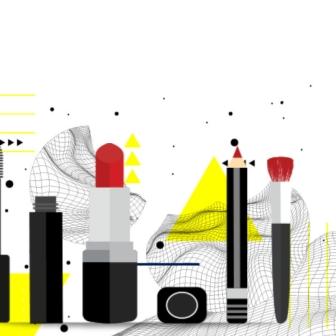
More Beauty Business Ideas
11. Full service beauty salon: Open a beauty salon offering a range of services such as haircuts, styling, colouring, manicures, pedicures, facials, waxing, and makeup application.
12. Spa and wellness centre: Start a spa and wellness centre offering a variety of treatments and services such as massages, body scrubs, aromatherapy, skincare treatments, and wellness consultations.
13. Nail salon: Open a nail salon specializing in nail care services such as manicures, pedicures, nail extensions, nail art, and gel polish.
14. Beauty product retail store: Start a retail store selling beauty products such as skincare, makeup, haircare, fragrances, and beauty tools. You can curate a selection of high-quality and popular brands to meet the needs and preferences of your customers.
15. Mobile beauty services: Offer mobile beauty services such as hairstyling, makeup application, and nail care for clients who prefer the convenience of having beauty services provided in their own homes or at their desired location.
16. Beauty subscription box: Create and sell beauty subscription boxes containing a curated selection of skincare, makeup, haircare, and beauty products. You can offer monthly or quarterly subscriptions and provide customers with a convenient way to discover and try new beauty products.
17. Beauty consulting and coaching: Offer beauty consulting and coaching services to individuals looking to enhance their personal grooming and beauty routines. You can provide personalized advice, product recommendations, and tutorials to help clients look and feel their best.
18. Bridal beauty services: Specialize in bridal beauty services such as bridal makeup, hairstyling, and grooming for weddings and special events. You can offer customized bridal packages and provide on-site services to brides and their bridal parties.
19. Eyelash extension studio: Open an eyelash extension studio offering professional eyelash extension services such as classic lashes, volume lashes, and lash lifts. You can provide customized lash designs to enhance the natural beauty of your clients’ eyes.
20. Beauty blog or vlog: Start a beauty blog or vlog where you share beauty tips, tutorials, product reviews, and trends with your audience. You can build a loyal following and monetize your content through affiliate marketing, sponsored posts, and advertising.
21. Beauty influencer or ambassador: Become a beauty influencer or brand ambassador on social media platforms such as Instagram, YouTube, or TikTok.
You can collaborate with beauty brands, promote their products, and share your expertise and recommendations with your followers.
22. Beauty event planning: Start an event planning business specializing in beauty events such as makeup workshops, beauty expos, or product launches.
You can help beauty brands and businesses organize and execute successful events to promote their products and services.
23. Organic and natural beauty products: Create and sell your own line of organic and natural beauty products made from clean and sustainable ingredients.
You can offer skincare, hair care, and body care products that are free from harmful chemicals and gentle on the skin.
24. Beauty photography and videography: Offer beauty photography and videography services for beauty brands, salons, spas, and individual clients for their product adverts and online marketing..
25. Beauty therapy and counselling: Provide beauty therapy and counselling services to clients who are struggling with issues such as body image, self-esteem, and confidence.
Offer personalized support, guidance, and techniques to help clients feel more confident and empowered in their own skin.

Fashion Business Ideas
1. Online clothing boutique: Start an online boutique offering a curated selection of clothing, accessories, and footwear for men, women, and children. .
2. Fashion design studio: Launch a fashion design studio where you create your own clothing line or offer custom design services for clients.
You can design and produce ready-to-wear collections, made-to-measure garments, or special occasion attire such as wedding dresses or evening gowns.
3. Fashion rental service: Start a fashion rental service where customers can rent designer clothing, accessories, and luxury items for special occasions or everyday wear.
You can offer a rotating selection of high-end fashion pieces at a fraction of the retail price, providing customers with access to luxury fashion without the commitment of ownership.
4. Fashion blog or influencer: Start a fashion blog or social media account where you share your personal style, fashion tips, outfit inspiration, and shopping recommendations with your followers.
Collaborate with brands, attend fashion events, and monetize your platform through sponsored content, affiliate marketing, and brand partnerships.
5. Fashion tech startup: Launch a fashion tech startup that develops innovative products, services, or apps to disrupt the fashion industry.
You can create virtual fitting tools, AI-powered style assistants, sustainable fashion platforms, or custom apparel manufacturing solutions that leverage technology to improve the fashion experience for consumers.
6. Fashion accessories brand: Start a brand specializing in fashion accessories such as jewellery, handbags, scarves, belts, and hats.
7. Fashion consulting and styling: Offer fashion consulting and styling services to individuals, businesses, or organizations looking to enhance their personal image, wardrobe, or brand identity.
Provide personalized styling sessions, wardrobe audits, shopping assistance, and fashion advice to help clients look and feel their best.
8. Sustainable fashion label: Launch a sustainable fashion label that prioritizes ethical sourcing, eco-friendly materials, and responsible manufacturing practices.
You can create clothing collections that are made to last, minimize environmental impact, and support fair labour standards, appealing to conscious consumers who value sustainability and social responsibility.
9. Fashion event planning: Start an event planning business specializing in fashion events such as runway shows, fashion weeks, trunk shows, or pop-up shops.
You can help fashion brands and designers showcase their collections, connect with buyers and influencers, and create memorable brand experiences that drive sales and brand awareness.
10. Fashion subscription box: Create and sell fashion subscription boxes containing curated clothing, accessories, and styling tips delivered to customers’ doorsteps on a regular basis.
Offer personalized styling services, trend forecasting, and outfit recommendations based on each customer’s preferences and style profile.
11. Fashion influencer marketing agency: Start an influencer marketing agency that connects fashion brands with influencers, bloggers, and social media personalities to promote their products and campaigns.
Help brands identify and collaborate with the right influencers to reach their target audience and drive engagement and sales.
12. Fashion resale platform: Launch a fashion resale platform where individuals can buy and sell pre-owned clothing, shoes, and accessories.
You can create a marketplace for secondhand fashion items, offering a sustainable and affordable alternative to fast fashion and reducing textile waste in the fashion industry.
13. Fashion education and training: Start a fashion education and training centre offering courses, workshops, and programs on various aspects of the fashion industry.
You can provide aspiring fashion professionals with hands-on training, industry insights, and networking opportunities to help them launch and advance their careers in fashion.
14. Fashion branding and marketing agency: Launch a branding and marketing agency specializing in fashion brands, helping them develop their brand identity, messaging, and marketing strategies.
Provide services such as brand consulting, creative direction, content creation, and digital marketing to help fashion brands stand out and connect with their target audience.
15. Fashion charity or nonprofit organization: Establish a charity or nonprofit organization dedicated to supporting emerging designers, artisans, and underprivileged communities in the fashion industry.
You can provide scholarships, mentorship programs, and resources to empower individuals and promote diversity, exclusivity, and social impact in fashion.

16. Organic skincare line: Create and sell your own line of organic skincare products using natural ingredients such as botanical extracts, essential oils, and vitamins.
You can offer products like cleansers, toners, serums, and moisturizers that cater to different skin types and concerns
17. Men’s grooming salon: Open a salon or barbershop specializing in men’s grooming services such as haircuts, beard trims, hot towel shaves, and skincare treatments.
Create a masculine and stylish atmosphere where men can relax and enjoy personalized grooming services.
18. Mobile spray tanning service: Start a mobile spray tanning service offering custom spray tans in the comfort of clients’ homes or offices.
You can provide safe and natural-looking tans using high-quality tanning solutions and equipment, catering to clients who want a sun-kissed glow without the harmful effects of UV exposure.
19. Beauty concierge service: Launch a beauty concierge service that offers personalized beauty experiences and services to clients, such as makeup consultations, skincare assessments, and beauty shopping assistance.
Provide expert advice, product recommendations, and VIP treatment to clients looking for a luxury beauty experience.
20. Hair extensions and wig boutique: Open a boutique specializing in hair extensions, wigs, and hairpieces for clients looking to enhance their hair length, volume, or style.
You can offer a wide range of options, including human hair extensions, synthetic wigs, and custom-made pieces to suit different preferences and budgets..
21. Beauty accessories brand: Launch a brand offering stylish and functional beauty accessories such as makeup brushes, cosmetic bags, hair accessories, and skincare tools.
22. Ayurvedic beauty spa: Open a spa specializing in Ayurvedic beauty treatments and holistic wellness therapies inspired by traditional Indian medicine.
Offer services such as Abhyanga massage, Shirodhara therapy, and herbal facials that promote balance, relaxation, and rejuvenation for mind, body, and spirit.
23. Beauty influencer agency: Start an influencer agency representing beauty influencers, content creators, and social media personalities in the beauty industry.
Help influencers monetize their platforms, negotiate brand partnerships, and create engaging content that resonates with their audience.
24. Beauty pop-up events: Organize and host beauty pop-up events in collaboration with beauty brands, retailers, and influencers.
You can create experiential beauty activation, product launches, and immersive brand experiences that engage consumers and drive brand awareness and sales.
25. Beauty podcast network: Launch a network of beauty podcasts covering a wide range of topics such as skincare, makeup, hair care, wellness, and beauty entrepreneurship.
Produce and distribute original podcast content featuring industry experts, influencers, and thought leaders to educate and inspire listeners.
26. Beauty subscription service for men: Create a subscription service offering curated boxes of grooming products and skincare essentials for men.
Also provide personalized recommendations, grooming tips, and product samples to help men discover new brands and upgrade their grooming routines.
27. Beauty recycling and upcycling program: Start a beauty recycling and upcycling program that collects used beauty products, packaging, and containers from consumers and repurposes them in environmentally friendly ways.
You can partner with beauty brands, retailers, and recycling facilities to promote sustainability and reduce waste in the beauty industry.
28. Beauty retreats and workshops: Organize and host beauty retreats and workshops in exotic destinations, offering immersive experiences focused on beauty, wellness, and self-care.
Provide participants with hands-on workshops, expert-led sessions, and rejuvenating spa treatments to nourish their bodies, minds, and spirits.
29. Beauty charity or nonprofit organization: Establish a charity or nonprofit organization dedicated to supporting undeserved communities and marginalized groups through beauty-related programs and initiatives.
You can provide access to beauty services, products, and education to empower individuals and promote self-confidence and self-esteem.
Want to Start Making Consistent Sales in Your Business?
Gain access to our FREE customer acquisition guide
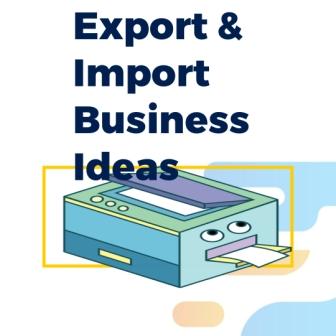
Import Export Business Ideas
Which product is best for import export business? What product is best to export from Nigeria? Embark on a global journey of opportunity with our curated collection of import and export business ideas.
Delve into lucrative markets, discover niche products that will make you money in the international market.
Trending products to import
1. Electronics: Smartphones, laptops, tablets, and other consumer electronics are consistently sought-after items in Nigeria.
2. Fashion and apparel: Clothing, footwear, and accessories from international brands are highly desired by Nigerian consumers who appreciate quality and trendy styles.
3. Beauty and skincare products: Cosmetics, skincare items, and hair care products from well-known brands are in high demand among Nigerian consumers who prioritize personal grooming and beauty.
4. Automotive parts: With a large number of vehicles on Nigerian roads, there is a constant need for automotive spare parts, tires, and accessories.
5. Home appliances: Household appliances such as refrigerators, washing machines, air conditioners, and kitchen gadgets are essential items for Nigerian households.
6. Health and wellness products: Vitamins, supplements, organic foods, and fitness equipment cater to the growing health-conscious population in Nigeria.
7. Baby and childcare products: Baby clothes, toys, strollers, and childcare essentials are always in demand as Nigeria has a large population of young families.
8. Agricultural products: Nigeria’s agricultural sector is vast, and there is often demand for imported agricultural machinery, equipment, and fertilizers to support farming activities.
9. Building materials: Construction materials like tiles, roofing materials, plumbing fixtures, and electrical components are needed for ongoing construction projects across Nigeria.
10. Food and beverages: Imported gourmet foods, specialty teas, and ethnic foods cater to the diverse tastes of Nigerian consumers who appreciate international cuisines.
Trending products to Export

1. Cocoa beans: Nigeria is one of the largest producers of cocoa beans globally, with demand from chocolate manufacturers in countries like the United States, Germany, Belgium, and the Netherlands. Cocoa beans are a key agricultural export product for Nigeria.
2. Sesame seeds: Nigerian sesame seeds are highly valued in international markets for their quality and flavor. Export destinations include China, Japan, Turkey, and the United States, where sesame seeds are used in food processing and oil extraction.
3. Cashew nuts: Nigeria is a leading exporter of cashew nuts, with demand from countries such as Vietnam, India, the United States, and the United Arab Emirates. Cashew nuts are used in snacks, confectionery, and food processing industries.
4. Shea butter: Nigerian shea butter is prized for its moisturizing and cosmetic properties, with demand from cosmetic companies in the United States, Europe, Japan, and South Korea. Shea butter is used in skincare products, cosmetics, and pharmaceuticals.
5. Ginger: Nigerian ginger is sought after in international markets for its aroma and flavour. Export destinations include China, India, the United States, and the United Kingdom, where ginger is used in food processing, beverages, and traditional medicine.
6. Leather products: Nigeria exports leather products such as shoes, bags, and garments to countries like Italy, Spain, China, and the United States. Nigerian leather is valued for its quality and durability in the fashion and accessories industries.
7. Palm oil: Nigeria is a major exporter of palm oil, with demand from countries such as India, China, the Netherlands, and Malaysia. Palm oil is used in food processing, cosmetics, and biofuel production.
8. Textiles and garments: Nigerian textiles and garments are exported to countries in West Africa, Europe, and the United States. Nigerian fabrics such as Ankara and Adire are popular in the fashion industry for their vibrant colours and unique designs.
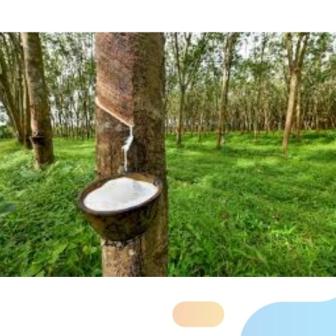
11. Rubber: Nigeria produces natural rubber, which is exported to countries like China, India, Malaysia, and Vietnam for use in tire manufacturing, automotive parts, and industrial applications.
12. Cassava: Nigeria is one of the largest producers of cassava in the world. Cassava products such as starch, flour, and chips are exported to countries in Africa, Europe, and Asia for food processing, animal feed, and industrial applications.
13. Timber and wood products: Nigeria exports timber and wood products such as plywood, veneer, and sawn timber to countries like China, India, the United States, and the United Arab Emirates for construction, furniture manufacturing, and woodworking industries.
14. Rubber products: In addition to natural rubber, Nigeria also exports rubber products such as rubber gloves, hoses, and footwear to countries in Africa, Europe, and Asia for various industrial and consumer applications.
15. Fish and seafood: Nigeria has a rich fishing industry, and fish products such as tilapia, catfish, and shrimp are exported to countries like Ghana, Benin, Spain, and the United States for food consumption and processing.
16. Fruits and vegetables: Nigerian fruits and vegetables such as pineapple, mango, watermelon, and okra are exported to countries in Europe, the Middle East, and North America for fresh produce markets and food processing industries.
17. Cocoa products: In addition to cocoa beans, Nigeria also exports cocoa products such as cocoa powder, cocoa butter, and cocoa liquor to countries like the Netherlands, the United States, and Germany for chocolate manufacturing and confectionery industries.
18. Palm kernel oil: Apart from palm oil, Nigeria also exports palm kernel oil to countries like India, China, the Netherlands, and Spain for food processing, cosmetics, and biodiesel production.
19. Groundnut (peanuts): Nigeria produces groundnuts (peanuts) for export to countries like India, China, Vietnam, and Turkey for food processing, peanut butter production, and snack industries.
20. Spices and herbs: Nigerian spices and herbs such as chili pepper, ginger, garlic and turmeric are in demand in countries in Europe, the Middle East, and Asia for culinary use and seasoning production.
21. Zobo leaves (hibiscus tea): Nigerian zobo leaves or hibiscus tea (used for herbal tea production and other industrial uses) are in hot demand in Mexico, America and other European countries. Mexico imports about 85% of Nigerian’s hibiscus flower or zobo.
22. Locally made braided wigs or weaves and attachments for making hair. Nigerians in diaspora are in need of these things and last year alone (2023) braided wigs worth over $1.16b was exported from Nigeria.
23. Cosmetics and soaps. Nigerians in diaspora import a lot of cosmetics and soaps from Nigeria every year.
Also, Nigerian soaps and cosmetics are also in huge demand in other African countries.
24. Snail. There is a ready market for snail as the demand is high in European countries and USA
25. Textile and garments. Spain, Portugal, USA, UK, Malaysia, Italy, Netherlands etc. need Nigerian textiles because of their texture and quality.
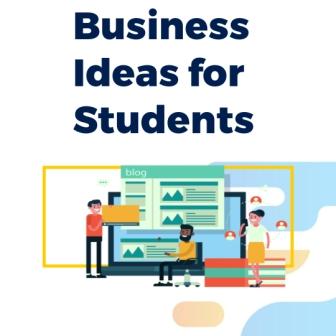
Business Ideas for Students
Which business can I do as a student in Nigeria? Listed below are business ideas you can start with little or no money as a student.
1. Tutoring: Offer tutoring services in subjects you excel in, whether it’s math, science, languages, or music. You can tutor fellow students or younger students in your community.
2. Academic writing services: Provide assistance with writing essays, research papers, and assignments for students who need help with academic writing tasks.
3. Graphic design: Use your creativity to offer graphic design services for logos, flyers, posters, and social media graphics for individuals and small businesses.
4. Social media management: Help businesses manage their social media accounts by creating content, scheduling posts, and engaging with followers.
5. Freelance writing: Write articles, blog posts, or website content for online publications, businesses, or individuals looking for freelance writers.
6. Photography: Offer photography services for events such as weddings, parties, or portrait sessions. You can also sell your photos online through stock photography websites.
7. Event planning: Plan and coordinate events such as parties, weddings, or corporate events for clients who need assistance with event organization.
8. Web design and development: Create websites for small businesses, organizations, or individuals who need an online presence.
9. Online reselling: Buy and sell products online through platforms like eBay, Amazon, or Etsy. You can sell items such as clothing, accessories, or handmade crafts.
10. Fitness coaching: Offer personalized fitness training or workout plans for individuals looking to achieve their health and fitness goals.
11. Virtual assistance: Provide administrative support services such as email management, scheduling appointments, or data entry for busy professionals or entrepreneurs.
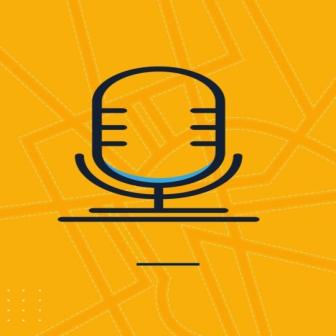
12. Language tutoring: Offer language tutoring services for students or professionals looking to learn a new language or improve their language skills.
13. Blogging or vlogging: Start a blog or YouTube channel to share your interests, hobbies, or expertise.
You can monetize your blog or channel through advertising, sponsorships, or affiliate marketing.
14. Mobile car washing/detailing: Offer mobile car washing and detailing services to busy individuals who need their cars cleaned and maintained.
15. Pet sitting or dog walking: Provide pet sitting services for pet owners who need someone to care for their pets while they’re away, or offer dog walking services for pet owners who need help exercising their dogs.
16. Social media influencer: Build a following on social media platforms such as Instagram, TikTok, or YouTube by creating engaging content in a niche that interests you.
Once you have a significant following, you can collaborate with brands for sponsored content or product promotions.
17. Phone repair services: offer phone repair services to fellow students.
18. Computer repair and tech support: Provide computer repair, troubleshooting, and tech support services for individuals or small businesses experiencing technical issues with their computers, laptops, or other electronic devices.
19. Virtual event planning: With the rise of virtual events, offer virtual event planning services for businesses, organizations, or individuals looking to host online conferences, webinars, or virtual parties.
20. Personal shopping service: Offer personal shopping services for busy professionals or individuals who need assistance with shopping for clothing, gifts, or groceries.
21. Gardening and landscaping: Provide gardening and landscaping services for homeowners or businesses looking to maintain their outdoor spaces.
22. Music lessons: If you’re skilled at playing a musical instrument or singing, offer music lessons to students who want to learn to play an instrument or improve their musical skills.
23. Mobile car repair: Provide mobile car repair services for minor car repairs and maintenance tasks such as oil changes, tire rotations, brake repairs, and battery replacements.
Offer your services to busy individuals who don’t have time to visit a mechanic.
24. Home organization and decluttering: Offer home organization and decluttering services for individuals or families who need help organizing their homes, decluttering their belongings, and creating functional and clutter-free living spaces.
Want to Start Making Consistent Sales in Your Business?
Gain access to our FREE customer acquisition guide
More Business Ideas for Students

25. Airbnb management: Provide Airbnb management services for property owners who rent out their homes or apartments on platforms like Airbnb.
Offer services such as guest communication, cleaning, and property maintenance to ensure a smooth and hassle-free experience for Airbnb hosts.
26. Mobile car detailing: Offer mobile car detailing services for car owners who want to keep their vehicles clean and well-maintained.
Provide services such as interior and exterior cleaning, waxing, and polishing at the client’s location.
27. Language translation services: If you’re proficient in multiple languages, offer language translation services for businesses, organizations, or individuals who need documents, websites, or content translated from one language to another.
28. Online fitness classes: Offer online fitness classes such as yoga, pilates, or HIIT workouts for individuals who want to exercise from the comfort of their own home.
Host live classes via video conferencing platforms or create pre-recorded workout videos.
29. House cleaning service: Provide house cleaning services for homeowners or renters who need help with regular cleaning tasks such as dusting, vacuuming, mopping, and bathroom cleaning.
You can offer one-time cleanings or recurring cleaning services based on your clients’ needs.
30. DIY crafts and handmade products: If you’re crafty and creative, make and sell handmade products such as jewellery, candles, soaps, or artwork.
You can sell your products online through platforms like Etsy or at local craft fairs and markets.
31. Mobile app development: If you have programming skills, consider developing mobile apps for businesses or individuals.
You can create custom apps for specific needs or develop your own apps to solve common problems or provide entertainment.
32. Remote tech support: Offer remote technical support services for individuals or businesses experiencing computer or software issues.
You can troubleshoot problems, provide guidance, and offer solutions remotely via phone, email, or video chat.
Want to Start Making Consistent Sales in Your Business?
Gain access to our FREE customer acquisition guide
33. Personal finance consulting: Help individuals or families with budgeting, saving, investing, and financial planning.
Offer personalized advice and strategies to help your clients achieve their financial goals and improve their financial literacy.
34. Custom clothing and accessories: Start a small clothing or accessory line where you design and create custom pieces such as T-shirts, hats, jewellery, or bags.
You can sell your products online through your own website or on platforms like Etsy.
35. Virtual assistant services: Provide virtual assistant services for busy professionals or entrepreneurs who need help with administrative tasks such as email management, scheduling appointments, data entry, or customer support.
36. Home repair and maintenance: Offer home repair and maintenance services for homeowners or renters who need help with minor repairs and tasks around the house.
You can fix leaky faucets, repair drywall, paint rooms, or assemble furniture.
37. Bicycle repair and maintenance: If you’re handy with tools, offer bicycle repair and maintenance services for cyclists in your area.
You can fix flat tires, adjust brakes, tune-up bikes, and perform other repairs and maintenance tasks.
38. Travel planning and booking: Help individuals or groups plan and book their travel arrangements such as flights, hotels, transportation, and activities.
39. Remote language tutoring: Offer remote language tutoring services for students or professionals looking to learn a new language or improve their language skills.
You can teach languages such as English, Spanish, French, or Mandarin via video chat or online platforms.
40. Digital marketing services: Help businesses or individuals with digital marketing tasks such as social media management, content creation, email marketing, SEO, and online advertising.
You can offer packages or services tailored to your clients’ needs and budgets.
41. Pet grooming services: Offer pet grooming services for pet owners who want to keep their furry friends clean and well-groomed.
Provide services such as baths, haircuts, nail trims, and ear cleaning for dogs and cats.

More Business Ideas for students
Interior design consultations: Provide interior design consultations for homeowners or renters who want to refresh their living spaces.
Provide advice on furniture arrangement, colour schemes, decor choices, and space planning to help your clients achieve their desired look and feel.
43. Remote transcription services: Offer remote transcription services for businesses, organizations, or individuals who need audio or video recordings transcribed into text.
Transcribe interviews, meetings, lectures, podcasts, or other audio/video content accurately and efficiently.
44. Online research services: Provide online research services for businesses, researchers, or students who need help gathering information, conducting surveys, or analyzing data.
You can offer research assistance for academic projects, market research, or business planning.
45. Digital product creation: Create and sell digital products such as e-books, online courses, templates, or digital artwork.
46. Remote transcription services: Provide transcription services for businesses, academic researchers, or podcasters who need audio or video files transcribed into text.
You can work from anywhere with an internet connection and good listening skills.
47. Home-based bakery: If you love baking, start a home-based bakery and sell your delicious creations to friends, family, and local customers.
You can specialize in cookies, cakes, bread, or pastries and take orders for special occasions like birthdays and weddings.
48. Personalized gift baskets: Create and sell personalized gift baskets for special occasions such as birthdays, weddings, or holidays.
49. Social media consulting: Offer consulting services to businesses or individuals looking to improve their social media presence and strategy.
Help with content creation, posting schedules, engagement strategies, and analytics tracking to help clients grow their online presence.
50. Meal delivery service: Start a meal delivery service for busy individuals or families who don’t have time to cook.
Prepare and deliver healthy, homemade meals to customers’ homes on a weekly or monthly basis.
51. Subscription box service: Create and sell subscription boxes filled with curated products tailored to specific interests or themes.
You may offer subscription boxes for beauty products, snacks, books, or hobby supplies and deliver them to customers’ doorsteps on a regular basis.
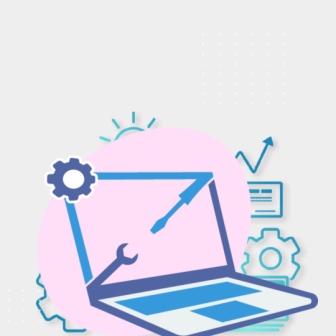
52. Virtual event planning: With the rise of virtual events, offer virtual event planning services for businesses or organizations looking to host online conferences, webinars, or virtual parties.
You can help with everything from event logistics to technical support and attendee engagement.
53. Dog training services: If you’re good with animals, start a dog training business and help pet owners train their furry friends.
54. Resume writing and career coaching: Provide resume writing and career coaching services to job seekers looking to land their dream job.
Help with resume writing, cover letter writing, interview preparation, and job search strategies to help clients stand out in a competitive job market.
55. DIY craft kits: Create and sell DIY craft kits containing all the materials and instructions needed to complete a specific craft project.
You can sell kits online through your own website or on platforms like Etsy and provide customers with a fun and creative activity they can enjoy at home.
56. Online language classes: Offer online language classes for individuals looking to learn a new language or improve their language skills.
57. Houseplant care services: Provide houseplant care services for busy homeowners or businesses who need help caring for their indoor plants.
Offer services such as watering, pruning, reporting, and pest control to keep plants healthy and thriving.
58. Sales of fairly used clothing (okirika) : Start selling fairly used clothes to fellow students. You can also sell online using social media.
59. Sustainable products store: Start an online store selling eco-friendly and sustainable products such as reusable bags, water bottles, straws, and household items.
60. Digital marketing agency: Start a digital marketing agency offering a range of services such as social media management, search engine optimization (SEO), content marketing, and email marketing to businesses.

Business Ideas for women in Nigeria
Which business is most profitable for women? Here are a list of business ideas for women in Nigeria.
1. Catering and event planning: start a catering and event planning business specializing in weddings, parties, and corporate events.
You can offer catering services, event decoration, venue styling, and coordination to help clients create memorable and stress-free events.
2. Home-based bakery: If you love baking, start a home-based bakery and sell cakes, cupcakes, pastries, and desserts.
You can take orders for special occasions like birthdays, weddings, and holidays, and offer delivery services to your customers.
3. Handmade crafts and accessories: Create and sell handmade crafts and accessories such as jewellery, bags, home decor items, and clothing.
4. Childcare services: Start a daycare or childcare centre offering a safe and nurturing environment for children while their parents are at work.
5. Health and wellness coaching: Offer health and wellness coaching services to help women achieve their fitness and wellness goals.
You can provide personalized guidance, support, and accountability to help clients improve their physical health, mental well being, and lifestyle habits.
6. Online tutoring or coaching: Start an online tutoring or coaching business offering educational services in subjects such as mathematics, STEM, language learning, career coaching, personal development etc.
7. Interior design and home decor: Start an interior design business offering services such as space planning, furniture selection, colour consulting, and home decor styling.
8. Digital marketing consultancy: Start a digital marketing consultancy offering services such as social media management, content creation, email marketing, and online advertising.

8. Boutique fitness studio: Open a boutique fitness studio offering specialized fitness classes such as yoga, pilates, dance, or HIIT workouts.
Create a welcoming and inclusive environment where women can exercise, socialize, and support each other on their fitness journey.
9. Natural skincare products: Start a skincare product line using natural and organic ingredients to create products such as cleansers, moisturizers, serums, and masks.
Sell your products online, at local markets, or through beauty stores and spas.
10. Mobile salon services: Offer mobile salon services such as hair styling, makeup application, and nail care for women who prefer the convenience of having beauty services provided in their own homes.
Cater to busy professionals, moms, or individuals with limited mobility.
11. Financial planning and consulting: Start a financial planning and consulting business offering services such as budgeting, savings strategies, investment advice, and retirement planning.
You can help women take control of their finances, build wealth, and achieve their financial goals.
12. Eco-friendly products store: Start an online store selling eco-friendly and sustainable products such as reusable bags, water bottles, skincare products, and household items.
13. Personal styling services: Offer personal styling services to clients who need help updating their wardrobe, choosing outfits for special occasions, or finding their personal style.
Provide fashion advice, shopping assistance, and wardrobe organization to help clients look and feel their best.
14. Cooking classes: Host cooking classes or workshops where you teach clients how to prepare delicious and healthy meals.
Focus on specific cuisines, dietary preferences, or cooking techniques and provide hands-on instruction in a fun and interactive setting.
15. Virtual assistant agency: Start a virtual assistant agency and provide administrative support services to businesses, entrepreneurs, and professionals.
You can hire and manage a team of virtual assistants who offer services such as email management, scheduling, data entry, and customer support.
16. Freelance writing and editing: Offer freelance writing and editing services to clients who need help with content creation, copywriting, or editing.
Write articles, blog posts, website copy, or marketing materials for businesses, publications, or online platforms.
Want to Start Making Consistent Sales in Your Business?
Gain access to our FREE customer acquisition guide
17. Event rental services: Start an event rental business offering rental equipment and decor for weddings, parties, and events.
You can rent out items such as tables, chairs, linens, tents, and decor items to clients who are hosting events.
18. Jewelry design and sales: Create and sell your own jewelry designs through online platforms, local markets, or boutique stores.
Design and make jewelry using various materials such as beads, gemstones, metals, or recycled materials.
19. Language translation and interpretation: Offer language translation and interpretation services for businesses, organizations, or individuals who need documents, websites, or meetings translated from one language to another.
Specialize in specific languages or industries and provide accurate and culturally sensitive translations.
20. Travel agency: Start a travel agency specializing in organizing and booking travel arrangements for individuals, families, or groups.
Help clients plan and book flights, accommodations, transportation, tours, and activities for their trips.
21. Home-based fitness coaching: Offer virtual fitness coaching services for clients who want to exercise from the comfort of their own home.
Create personalized workout plans, provide virtual coaching sessions, and offer support and accountability to help clients achieve their fitness goals.
22. Handmade home decor products: Create and sell handmade home decor products such as candles, pottery, textiles, or artwork.
23. Green cleaning services: Start a green cleaning business offering eco-friendly and non-toxic cleaning services for homes and businesses.
Use environmentally friendly cleaning products and methods to provide safe and effective cleaning solutions to your clients.
24. Online boutique: Start an online boutique selling a curated selection of clothing, accessories, and lifestyle products for women.
25. Personal finance blog or consultancy: Start a personal finance blog or consultancy offering advice, tips, and resources to help women manage their finances, save money, and achieve financial independence.
You can share your expertise on topics such as budgeting, investing, debt management, and retirement planning.
26. Homemade skincare products: Create and sell homemade skincare products using natural and organic ingredients such as essential oils, herbs, and botanical extracts.
You can make products such as cleansers, moisturizers, masks, and serums and sell them online or at local markets.
27. Eco-friendly fashion line: Start a fashion line specializing in eco-friendly and sustainable clothing and accessories.
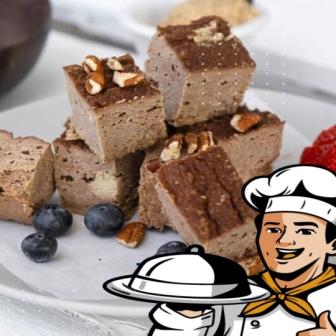
28. Home-based bakery: Start a home-based bakery and specialize in baking and selling cakes, cupcakes, pastries, and desserts.
You can offer custom-designed cakes for weddings, birthdays, and other special occasions, as well as a variety of baked goods for everyday enjoyment.
29. Interior decorating services: Offer interior decorating services to help clients transform their homes or offices into stylish and functional spaces.
Offer provide consultations, space planning, colour coordination, furniture selection, and decor recommendations to meet your clients’ needs and preferences.
30. Mobile beauty services: Provide mobile beauty services such as hair styling, makeup application, manicures, and pedicures to clients in the comfort of their own homes.
You can offer on-demand beauty services for special occasions like weddings, parties, or photo shoots.
31. E-commerce store: Start an e-commerce store selling a curated selection of products such as clothing, accessories, beauty products, home goods, or specialty foods.
You can create an online storefront and reach customers nationwide or even globally.
32. Health and wellness coaching: Become a health and wellness coach and help clients achieve their fitness, nutrition, and lifestyle goals.
You can offer personalized coaching, meal planning, workout routines, and support to help clients improve their overall health and well-being.
33. Virtual event planning: Offer virtual event planning services for businesses, organizations, and individuals looking to host online conferences, webinars, workshops, or virtual parties.
You can handle everything from event coordination and logistics to technical support and attendee engagement.
34. Homemade food products: Create and sell homemade food products such as moi moi, pap, snacks, or baked goods.
35. Online courses or workshops: Create and sell online courses or workshops on topics such as entrepreneurship, personal development, cooking, crafts, or wellness.
36. Virtual assistant services: Offer virtual assistant services to entrepreneurs, executives, or small businesses who need help with administrative tasks such as email management, scheduling, data entry, research, or social media management.
37. Boutique fitness studio: Open a boutique fitness studio offering specialized fitness classes such as yoga, pilates, barre, or dance.
You can create a welcoming and inclusive environment where women can exercise, socialize, and prioritize their health and well-being.
38. Personalized stationery and gifts: Create and sell personalized stationery, greeting cards, invitations, and gifts for special occasions such as weddings, birthdays, or holidays.
You can offer custom-designed products that reflect your clients’ style and personality.
39. Translation and interpretation services: Offer translation and interpretation services for businesses, organizations, or individuals who need help communicating in multiple languages.
40. Sustainable fashion rental service: Start a sustainable fashion rental service where customers can rent high-quality, designer clothing and accessories for special occasions or everyday wear.
You can promote sustainability and reduce fashion waste by offering a convenient and affordable rental option.
41. Freelance photography: Start a freelance photography business specializing in portrait photography, event photography, product photography, or lifestyle photography.
Want to Start Making Consistent Sales in Your Business?
Gain access to our FREE customer acquisition guide
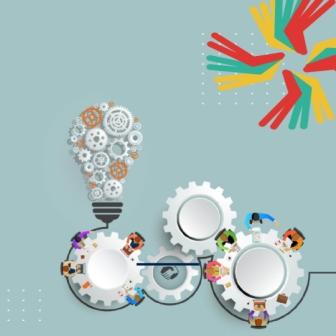
42. Art therapy workshops: Offer art therapy workshops for individuals or groups looking to explore their creativity, reduce stress, and improve their mental well-being.
You can provide guided art activities, therapeutic exercises, and supportive environments for participants to express themselves through art.
43. Online boutique for modest fashion: Start an online boutique specializing in modest fashion clothing and accessories for women.
You can offer a wide range of stylish and modest clothing options, including dresses, skirts, tops, and hijabs, to cater to the needs of Muslim women and others who prefer modest dressing.
44. Handcrafted home decor: Create and sell handcrafted home decor items such as wall art, decorative pillows, candles, and pottery.
You can use locally sourced materials and traditional crafting techniques to produce unique and artisanal products that add a personal touch to customers’ homes.
45. Online fitness coaching for moms: Offer online fitness coaching services specifically designed for moms who want to prioritize their health and well-being.
You can provide personalized workout plans, nutritional guidance, and support to help moms stay fit and active while balancing their busy schedules.
46. Organic skincare products: Develop and sell your own line of organic skincare products made from natural ingredients such as plant extracts, essential oils, and botanicals.
You can create products such as cleansers, moisturizers, serums, and masks that are gentle, nourishing, and free from harmful chemicals.
47. Personal styling subscription service: Launch a personal styling subscription service where customers receive personalized style recommendations and curated clothing selections delivered to their doorstep on a regular basis.
You can offer styling services tailored to each customer’s preferences, body type, and lifestyle needs.
48. Homemade pet treats and accessories: Create and sell homemade pet treats, toys, and accessories for dogs and cats. You can use high-quality ingredients and innovative designs to produce pet products that are healthy, safe, and enjoyable for pets and their owners.
49. Virtual language learning platform: Create a virtual language learning platform where users can access interactive lessons, language exercises, and cultural resources to learn a new language or improve their language skills.
You can offer courses in languages such as English, French, Spanish, or local Nigerian languages.
50. Sustainable agriculture consultancy: Start a consultancy offering sustainable agriculture solutions and services to farmers, agricultural businesses, and government organizations.
You can provide expertise in areas such as organic farming practices, crop rotation, soil conservation, and water management to promote environmental sustainability and increase crop yields.
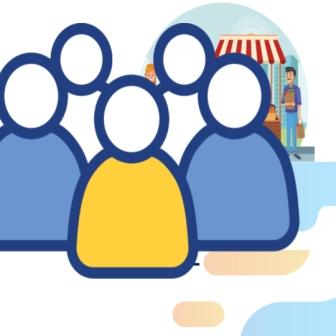
51. Online parenting community and resource hub: Launch an online platform and community for moms and parents where they can connect, share experiences, and access resources and support on various parenting topics.
You can offer articles, forums, webinars, and expert advice to help parents navigate the challenges of parenthood.
52. Digital content creation agency: Start a digital content creation agency offering services such as content writing, graphic design, video production, and social media management.
You can work with businesses, brands, and influencers to create engaging and compelling content that resonates with their target audience.
53. Plant-based food delivery service: Launch a plant-based food delivery service offering nutritious and delicious vegan and vegetarian meals delivered to customers’ homes or workplaces.
You can provide meal plans, individual dishes, or catering options for customers looking to adopt a plant-based lifestyle.
54. Wellness retreats and workshops: Organize wellness retreats and workshops focused on holistic health and well-being, including yoga, meditation, mindfulness, nutrition, and self-care practices.
55. Custom embroidery and monogramming services: Offer custom embroidery and monogramming services for personalized gifts, clothing, accessories, and home decor items.
You can create custom designs, logos, and monograms to add a personal touch to your customers’ belongings.
56. Social impact consulting firm: Start a consulting firm specializing in social impact and corporate social responsibility (CSR) strategies for businesses and organizations.
You can help clients develop and implement initiatives that make a positive difference in society while aligning with their values and goals.
57. Online wellness marketplace: Create an online marketplace where customers can discover and purchase a wide range of wellness products and services, including natural remedies, holistic therapies, fitness equipment, and wellness experiences.
You can partner with vendors and practitioners to offer a diverse selection of wellness offerings to your customers.

Real Estate Business Ideas
A lot of people are wondering how to make money from real estate in Nigeria. Others ask how to start real estate business without money..
There are a lot of ways to make money from real estate,
Here, we have listed real estate business ideas that will help you start and grow your own business in the lucrative real estate industry.
1. Property management: Offer property management services to real estate investors or property owners who need assistance with managing their rental properties.
You can handle tasks such as tenant screening, rent collection, property maintenance, and lease enforcement on behalf of your clients.
2. Real estate agency: Start a real estate agency and help clients buy, sell, or rent residential, commercial, or industrial properties.
You can work with buyers to find their dream homes, assist sellers in marketing their properties, and negotiate deals on behalf of your clients.
3. Real estate investment: Invest in real estate properties yourself by purchasing residential, commercial, or rental properties and renting them out for passive income.
You can also flip properties by buying distressed properties, renovating them, and selling them for a profit.
4. Real estate photography: Start a business offering real estate photography services to real estate agents, brokers, and property owners.
You can take professional photos of properties to showcase their features and attract potential buyers or renters.
5. Shortlet property management: Manage shortlet properties on behalf of owners who rent them out to travellers on platforms like Airbnb or VRBO.
You can handle bookings, guest communication, cleaning, and property maintenance to ensure a positive experience for both owners and guests.
6. Start shortket business: Rent apartments or build rooms, flats and duplexes, furnish and offer it to travellers, people on vacation as a home outside their homes and get paid on a daily basis.
7. Real estate appraisal: Become a certified real estate appraiser and provide appraisal services to determine the value of properties for buyers, sellers, lenders, or investor.
Want to Start Making Consistent Sales in Your Business?
Gain access to our FREE customer acquisition guide
8. Real estate consulting: Start a consulting business offering expert advice and guidance on various aspects of the real estate industry.
You can provide consulting services to individuals, businesses, or organizations on topics such as market analysis, investment strategies, property development, or regulatory compliance.
9. Property flipping: Buy distressed properties at a discounted price, renovate them to improve their value and appeal, and then sell them for a profit.
10. Real estate crowdfunding: Start a real estate crowdfunding platform that allows investors to pool their money together to invest in real estate properties.
You can offer investors the opportunity to invest in properties without the need for large amounts of capital or direct property ownership.
11. Real estate education and training: Start a business offering real estate education and training programs for aspiring real estate professionals.
You can offer courses, workshops, seminars, or online resources covering topics such as real estate licensing, sales techniques, investment strategies, and property management.
12. Real estate software development: Develop and sell software solutions specifically designed for real estate professionals, such as property management software, CRM systems, marketing platforms, or investment analysis tools.
13. Virtual real estate brokerage: Start a virtual real estate brokerage that operates entirely online, allowing agents to work remotely and serve clients without the need for a physical office.
You can leverage technology to offer virtual property tours, digital transactions, and remote consultations, making it convenient for clients to buy, sell, or rent properties from anywhere.
14. Real estate investment trusts (REITs): Launch a real estate investment trust (REIT) that allows investors to pool their money to invest in income-generating real estate properties, such as rental apartments, office buildings, or shopping centers.
REITs provide investors with the opportunity to earn dividends and participate in real estate ownership without directly owning properties.
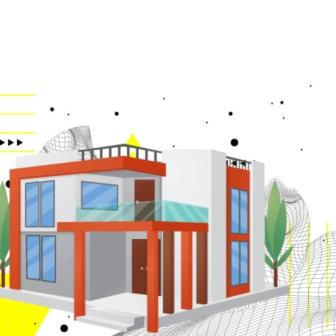
16. Real estate podcast or blog: Create a podcast or blog focusing on real estate topics such as market trends, investment strategies, property management tips, or home buying/selling advice.
You can provide valuable insights, interviews with industry experts, and actionable tips to educate and engage your audience of real estate enthusiasts.
17. Real estate auction services: Offer real estate auction services for properties that are being sold through auction, either online or in-person. .
18. Real estate tax consulting: Start a consulting business offering tax planning and compliance services to real estate investors, property owners, and developers.
You can help clients navigate complex tax regulations, identify tax-saving opportunities, and optimize their tax strategies to minimize liabilities and maximize returns on their real estate investments.
19. Affordable housing development: Focus on developing affordable housing projects that provide quality and affordable housing options for low- and middle-income families.
20. Real estate crowdfunding platform: Launch a real estate crowdfunding platform that connects investors with real estate developers and projects seeking funding.
21. Real estate data analytics: Start a business specializing in real estate data analytics and market intelligence, providing insights and actionable data to real estate professionals, investors, and decision-makers.
You can collect, analyze, and interpret data on market trends, property values, demographic shifts, and investment opportunities to help clients make informed decisions and gain a competitive edge in the real estate market.
22. Real estate coaching and mentorship: Offer coaching and mentorship programs for aspiring real estate professionals, providing guidance, support, and accountability to help them succeed in their real estate careers.
You can share your knowledge, experience, and best practices to help individuals navigate the complexities of the real estate industry and achieve their goals.
23. Real estate sustainability consulting: Start a consulting firm specializing in sustainable real estate development and green building practices.
You can help developers, investors, and property owners incorporate sustainability principles into their projects, such as energy efficiency, renewable energy, water conservation, and green building certifications, to create environmentally friendly and socially responsible properties.
24. Real estate drone photography: Offer drone photography and videography services for real estate properties, providing aerial views and stunning visuals to showcase properties in a unique and captivating way.
You can help real estate agents, developers, and property owners highlight the features and amenities of properties and attract potential buyers or renters.
25. Real estate co-working spaces: Develop and operate co-working spaces specifically designed for real estate professionals, offering shared office spaces, meeting rooms, and amenities tailored to their needs.
You can create collaborative and productive environments where real estate agents, brokers, investors, and service providers can network, collaborate, and grow their businesses together.
Looking for where to register your business? Find out more here
CONCLUSION:
So, here you have it. Here are the small business ideas in Nigeria. As you can see, the entrepreneurial landscape in Nigeria is ripe with opportunities for individuals looking to start their own businesses and make their mark in various industries. From agriculture to technology, fashion to beauty, there are countless small business ideas that cater to different interests, skills, and market demands.
What’s more, the digital revolution has opened up new avenues for innovation and entrepreneurship, allowing you to reach wider audiences, access new markets, and scale your ventures more efficiently than ever before.
However, success in entrepreneurship requires more than just a good idea – it also requires determination, resilience, and a willingness to adapt to changing circumstances.
Whether you’re a seasoned entrepreneur or just starting out, the key is to stay focused, stay agile, and never stop learning and growing.
So, if you’ve been dreaming of starting your own business in Nigeria, now is the time to take action.
With the right mindset, strategy, and execution, you can turn your small business idea into a thriving venture that contributes to the growth and prosperity of Nigeria’s economy.
Remember, the journey of entrepreneurship may have its challenges, but the rewards of building something meaningful and impactful are well worth the effort.
So, go ahead – use any of these small business ideas in Nigeria, seize the opportunity, chase your dreams, and embark on the exciting adventure of entrepreneurship in Nigeria today.
Want to Start Making Consistent Sales in Your Business?
Gain access to our FREE customer acquisition guide
Share this with friends!

AI and Automation Free Sales masterclass
Want to learn how to use ai and automation to sell your products faster using organic marketing strategies? Join this free masterclass
This FREE masterclass was created by Martin Boeddeker. Martin is the CEO of FindFocus, a leading authority in scaling organic marketing with AI and sales automation. He owns two businesses generating six-figures revenue, as both an affiliate and a course creator.
He specializes in leveraging free traffic strategies to increase sales faster using AI and automation, making him an authority in scaling organic marketing.
This FREE masterclass was brought to you in partnership with Ads Made Free, a brand of Martin Boeddeker.
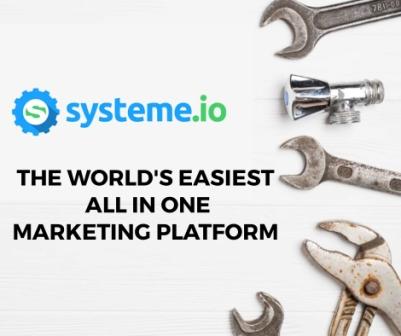
Systeme.io Review: My Honest Review – All in one Business Automation Tool
Hi. This is Chinny. Today, I will take you through a detailed comprehensive Systeme.io review based on my experience of using this all in one business growth tool.
Finding the right platform to streamline business operations and drive growth can be akin to finding a needle in a haystack.
Amidst the quest for efficiency and effectiveness, Systeme.io emerges as a contender, promising an all-in-one solution for entrepreneurs seeking to establish and expand their digital presence.
What exactly is Systeme.io, and does it live up to the hype? Is Systeme.io worth it? In this in-depth review, we delve into the heart of Systeme.io, dissecting its features, functionalities, and overall suitability for businesses of all shapes and sizes.
From website building to email marketing, sales funnel optimization to e-commerce management, we leave no stone unturned in our exploration of this multifaceted platform.
Join me as I uncover everything you need to know about Systeme.io’s capabilities, its strengths, weaknesses, and everything in between.
Whether you’re a seasoned entrepreneur looking to streamline your operations or a budding startup seeking the perfect launchpad, this review aims to equip you with the knowledge and insights necessary to make an informed decision.
So, let’s dive into the world of Systeme.io and discover whether it’s the missing piece to your online business puzzle.
Table of Contents
What is Systeme.io
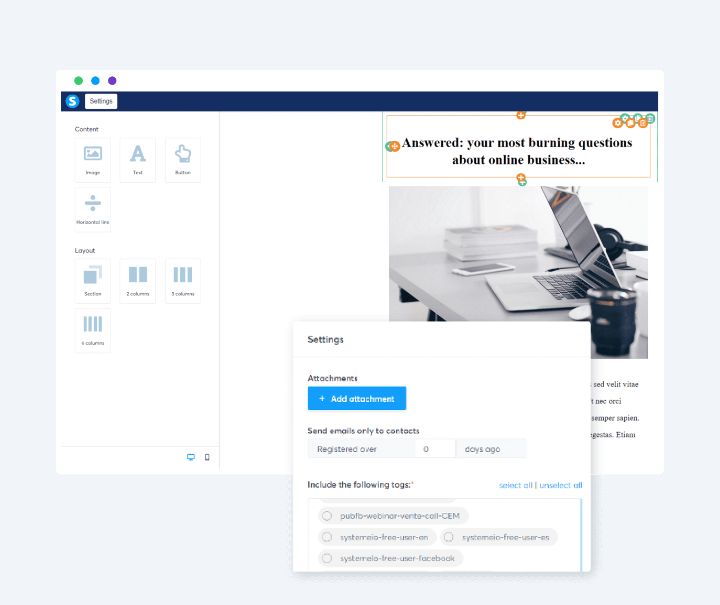
Systeme.io is an all-in-one platform designed to empower entrepreneurs and small businesses to succeed online.
It seamlessly integrates essential tools and features to streamline every aspect of your online business, from building your website and creating sales funnels to automating your email marketing campaigns, creating courses, selling products online, building an online community and managing your affiliate program.
With Systeme.io, you have EVERYTHING (this is not an exaggeration) you need to launch, grow, and scale your online business all in one place.
Whether you’re a solopreneur, freelancer, or small business owner, Systeme.io’s intuitive interface, drag-and-drop builders, and robust features make it easy for you to create a professional online presence, attract and convert customers, and maximize your revenue potential for just $27 . . .and it comes with a free plan that you can start with and upgrade later.
You don’t need to learn how to use many other software to be able to run your business if you are using Systeme.io. It helps to reduce the time you spend on learning how to use different software . . .and the cost of purchasing several software too.
If you pay for Systeme.io using our link, you will also gain access to my step by step video tutorials on how to setup Systeme.io plus a free copy of my course “From Zero to 7 Figure brand that will help you create an automated sales funnel in your business . . . helping you to make money while you sleep.
Disclosure: if you make a purchase using our links, we are compensated at no extra cost to you
Systeme.io reviews and User Feedback
We recommend only business tools we have tested and have seen help other entrepreneurs grow their businesses. We used Systeme.io to build the sales funnel for this site and also use it fully for one of our brands. So, we only recommend what we know will work for your business.
Here are some of the success stories of businesses using Systeme.io.
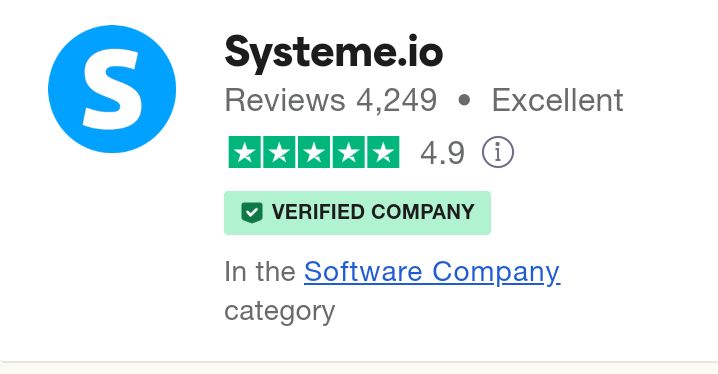
MailChimp and ConstantContact Bye
“This company is incredibly responsive and efficient! They promptly address inquiries and provide effective solutions. When I initially turned to the platform seeking alternatives to MailChimp and ConstantContact, I was pleasantly surprised to discover a wealth of additional features. Not only does their email system perform admirably, but I can also effortlessly construct sales funnels, offer courses for sale, and establish automated email sequences for new subscribers. The only aspect I find lacking is a more robust CRM. However, the platform does offer a convenient option for selling courses through affiliates. I highly recommend getting “certified” on their platform—it’s a swift, straightforward process that yields significant benefits.”
Charisa
This software suite is almost perfect.
“This software suite offers outstanding value for its price. The team behind it demonstrates a genuine commitment to enhancing the product.
My only suggestion for improvement would be to implement a partner split program within their affiliate program. This would incentivize a broader range of individuals, including coaches who may not be affiliate marketers, to promote Systeme.io. Specifically, awarding credit to both the first signup via email and the last cookie leading to the sale would greatly expand the pool of potential promoters.”
Chris Fox
Say Good bye to costly platforms
“Absolutely happy about Systeme.io!
For affiliate marketers like myself, discovering an all-in-one tool has been a game-changer.
The free plan alone offers an incredible package—landing pages, sales funnels, domain connection—all without denting your wallet.
In contrast to its pricier counterparts, Systeme.io’s $27/month plan covers everything you’d typically shell out $97 for elsewhere.
The seamless ability to create membership sites, online courses, and blogs is a huge victory.
While it continues to evolve, the undeniable value for money remains. Although integration options may be limited, for an all-encompassing marketing system, it’s my top recommendation.
Give the free plan a try and experience the benefits!
Jose Coenraad
I love this platform
I’m thrilled with this platform! It’s a remarkable system! I’ve used much more expensive and complicated systems where support is slow to respond. But this platform has everything you need for your online marketing business at an affordable price, with excellent and fast support. Plus, it offers countless opportunities to earn money, like reselling other people’s courses, and much more! I’m absolutely delighted with my choice!
Maribou Latour
Read more Systeme.io reviews
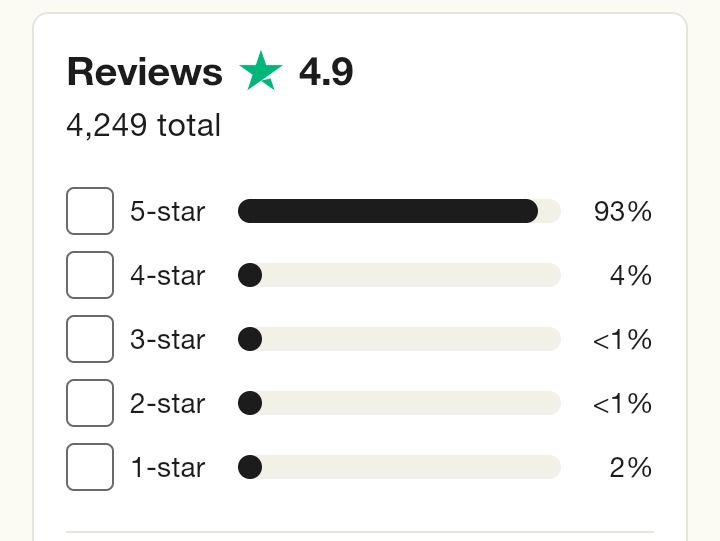
Systeme.io features
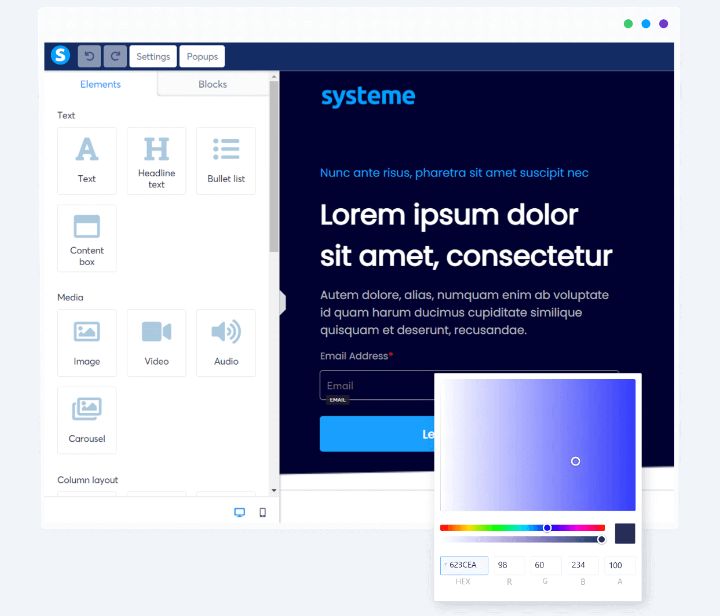
A lot of people are asking, what can I do with Systeme.io? What does Systeme.io offer?
Here are the all in one features you would be enjoying when you start using Systeme.io:
1. Website Building:
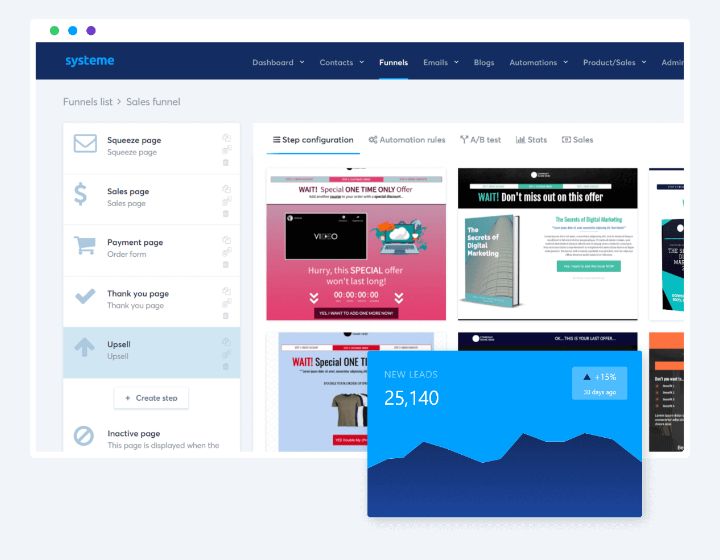
Does Systeme.io offer templates for building websites and sales funnels?
Yes, Systeme.io enables users to create professional-looking websites without any coding knowledge or design experience.
The platform offers a drag-and-drop website builder with customizable templates, allowing users to easily customize their site’s layout, colours, fonts, and content to match their brand identity.
Anyone that can browse the internet can use Systeme.io to setup an automated online business. It’s that simple.
2. Sales Funnel Creation:
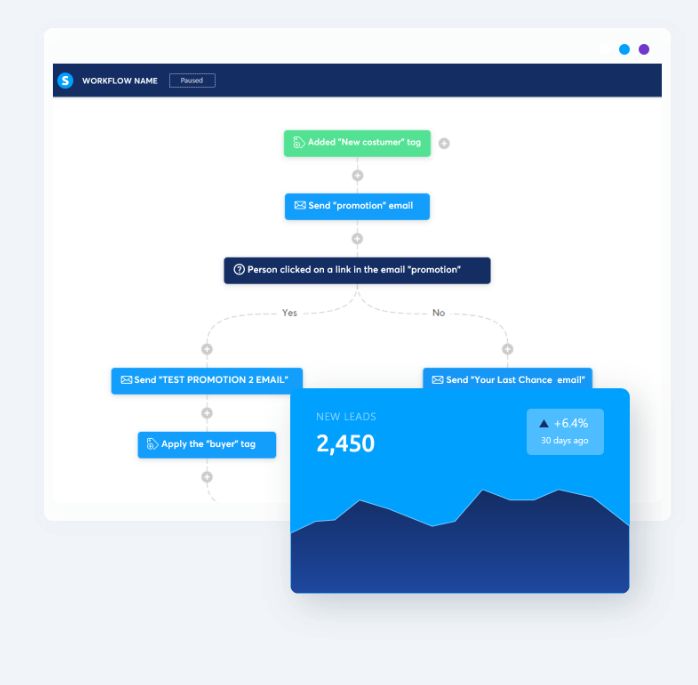
Sales funnels are crucial for guiding visitors through the buyer’s journey and converting them into customers.
Here is what sales funnel means. A sales funnel is a step by step process you take a potential customer through your business until he/she becomes a customer.
The beauty of using an automated sales funnel builder like systeme.io is that you would be able to setup your sales funnel once and it becomes almost hands free, so you make money on auto pilot even when you are busy with other things.
Systeme.io provides a user-friendly sales funnel builder that allows users to create high-converting sales funnels with ease. Users can design funnels for various purposes, such as lead generation, product sales, customer feebacks, webinar registrations, or upselling/downselling etc.
Learn how to easily get customers that are eager to buy what you sell in this free Guide.
3. Email Marketing Automation:

Does systeme.io have email automation?
Email marketing is a powerful tool for nurturing leads, engaging customers, and driving sales. Systeme.io includes robust email marketing automation features, allowing users to create and automate personalized email sequences, broadcasts, and follow-up emails. Users can segment their email lists, track email performance metrics, and optimize campaigns for better results.
How many emails can I send with Systeme.io?
With Systeme.io, you are allowed to send unlimited emails in all its plans unlike other email marketing platforms that limit the number of emails you can send.
4. E-commerce Management:
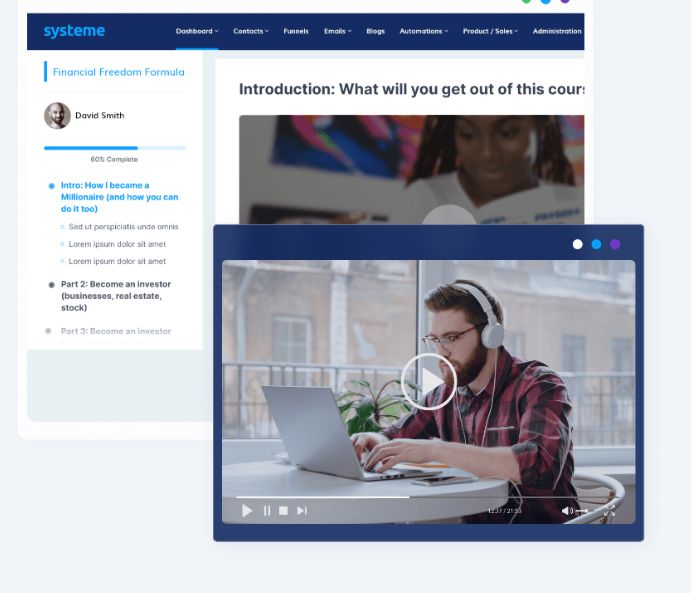
Is Systeme.io suitable for e-commerce businesses, online courses, or membership sites?
For businesses selling products or services online, Systeme.io offers built-in e-commerce capabilities. Users can set up an online store, manage product listings, process orders, and accept payments seamlessly within the platform.
Systeme.io also provides tools for managing inventory, and generating sales reports. Systeme.io supports payments through popular payment processors on all its plans like:
- Stripe.
- PayPal.
- Paystack
- Mercado Pago.
- Razorpay.
- Flutterwave.
- Mollie.
5. Membership Site Creation:
Systeme.io allows users to create and manage membership sites to deliver exclusive content, courses, or services to their subscribers.
Users can set up membership levels, restrict access to content based on subscription tiers, and automate member registration and management processes.
6. Affiliate Program Management:
Systeme.io includes features for creating and managing affiliate programs, allowing users to recruit affiliates, track referrals, and manage commissions. This enables businesses to leverage affiliate marketing to expand their reach, drive traffic, and increase sales.
7. Analytics and Reporting:
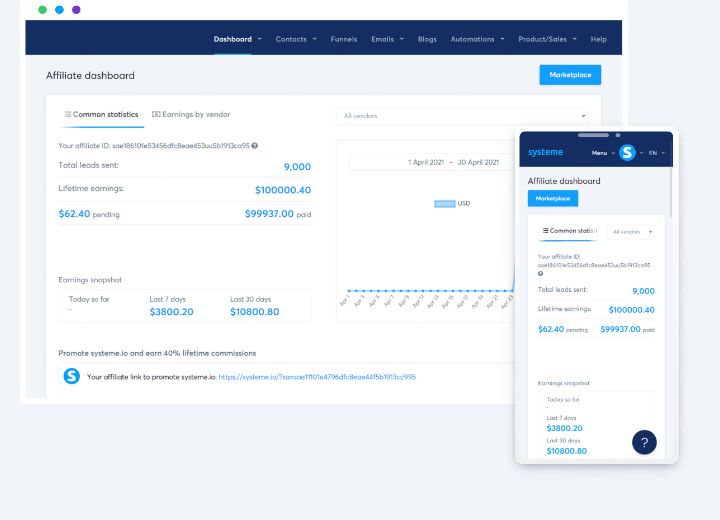
Systeme.io provides users with comprehensive analytics and reporting tools to track the performance of their marketing efforts.
Users can monitor website traffic, conversion rates, email engagement metrics, and sales data to gain insights into their business’s performance and make data-driven decisions.
8. Marketing Automation Workflows:
Systeme.io enables users to create automated marketing workflows to streamline repetitive tasks and processes. Users can set up triggers, actions, and conditions to automate tasks such as lead generation, customer onboarding, and follow-up communications.
9. Online Community
With Systeme.io, you can create an online community. You may choose to create a private or a public online community.
10. CRM (Customer Relationship Management):
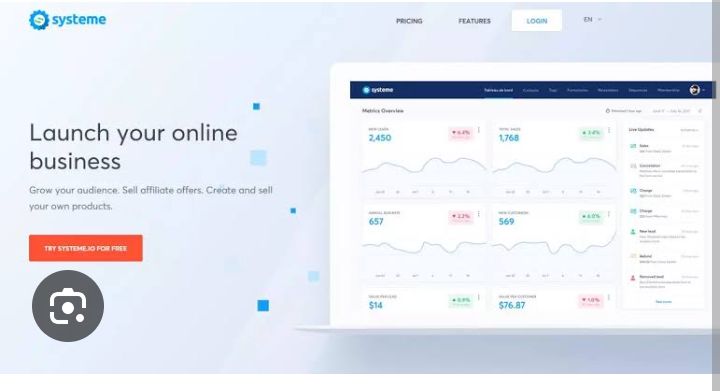
Systeme.io provides built-in CRM features to help users manage customer relationships more effectively. Users can track customer interactions, store contact information, and segment their audience based on various criteria to personalize their marketing efforts.
Overall, Systeme.io simplifies the process of launching and growing an online business by providing an integrated suite of tools and functionalities tailored to meet the needs of entrepreneurs and small businesses.
Whether you’re a solopreneur, freelancer, or small business owner, Systeme.io offers the tools and support you need to succeed in the competitive world of online business.
Is Systeme.io easy to use for beginners?

Based on real user experiences, Systeme.io is generally considered beginner-friendly. Many users praise the platform for its intuitive interface, easy-to-use tools, and helpful tutorials.
The drag-and-drop builders make it simple for beginners to create professional-looking websites and sales funnels without any coding knowledge.
Additionally, Systeme.io’s customer support team is responsive and provides assistance to users who may encounter difficulties. Overall, Systeme.io’s user-friendly design and robust feature set make it a popular choice for beginners looking to establish and grow their online businesses.
Performance and Reliability
Speed and uptime performance:
Systeme.io generally performs well in terms of speed and uptime performance. Users often report satisfactory loading times for their websites and sales funnels, with minimal downtime or disruptions.
While occasional issues may arise, such as slow loading times during peak usage periods or isolated instances of downtime, these occurrences are typically rare and quickly resolved by Systeme.io’s technical team.
Scalability for growing businesses:
In terms of scalability for growing businesses, Systeme.io is often praised for its ability to accommodate businesses of various sizes and needs.
The platform offers flexible pricing plans that allow users to upgrade their accounts as their businesses grow, providing access to additional features and resources to support increased traffic and sales.
Many users appreciate the scalability of Systeme.io, as it allows them to expand their online presence and capabilities without experiencing significant performance issues.
Customer support quality and responsiveness:
Regarding customer support quality and responsiveness, Systeme.io receives positive feedback from users for its attentive and helpful customer support team.
Users report prompt responses to inquiries and issues, with the support team providing clear and actionable solutions to address concerns.
Whether through email, live chat, or support tickets, users find that Systeme.io’s customer support team is readily available to assist with technical issues, account management, or general inquiries, contributing to a positive overall user experience.
While occasional issues may arise, the platform generally delivers on its promises of providing a reliable and user-friendly solution for building and managing online businesses.
Security and Data Protection
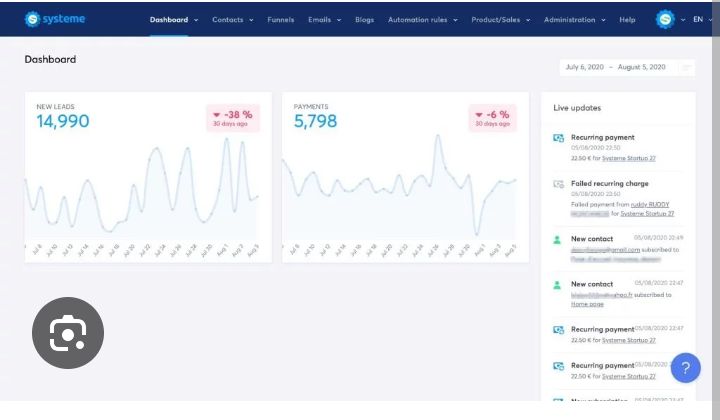
Systeme.io prioritizes the security and protection of user data through various measures to ensure peace of mind for its users.
Data Encryption:
Systeme.io employs robust encryption protocols to safeguard user data during transmission and storage. This ensures that sensitive information such as personal details and payment data are protected against unauthorized access or interception.
Secure Hosting:
The platform utilizes secure hosting infrastructure to store user data, employing industry-standard security practices to prevent data breaches or unauthorized access to user information.
Access Controls:
Systeme.io implements stringent access controls to limit access to user data only to authorized personnel who require it for legitimate purposes. This helps prevent unauthorized access or misuse of user information.
Regular Audits and Monitoring:
Systeme.io conducts regular security audits and monitoring to identify and address any potential vulnerabilities or threats to user data. This proactive approach helps ensure that the platform remains secure.
Complies with data protection regulations:
Systeme.io is committed to complying with relevant data protection regulations, including the General Data Protection Regulation (GDPR) and other applicable laws and regulations.
This includes implementing measures such as data minimization, user consent mechanisms, and transparent data processing practices to protect user privacy rights.
Overall, Systeme.io demonstrates a strong commitment to ensuring the security and protection of user data through robust security measures and compliance with relevant regulations.
Users can trust that their information is safeguarded and handled responsibly while using the platform for their online business needs.
Systeme.io Pricing
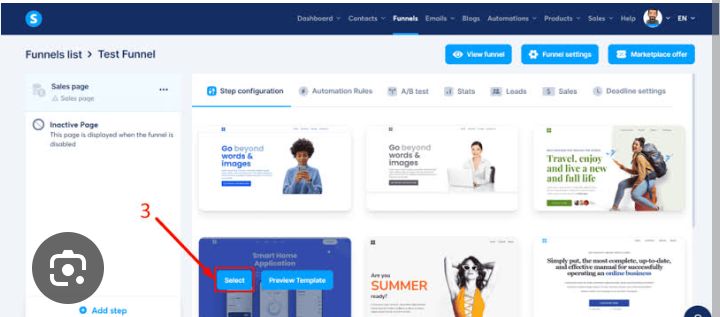
Systeme.io offers a range of pricing tiers designed to cater to various business needs and budgets. Here’s an overview of Systeme.io’s pricing tiers:
Free Plan:
Systeme.io provides a free forever plan with limited features, allowing users to explore the platform and its capabilities at no cost. While the free plan offers basic functionality, you need to upgrade to a paid plan for access to more advanced features and resources.
Paid Plans:
Systeme.io offers several paid plans with tiered pricing based on the number of contacts and sales starting from $27.
These plans provide access to additional features and resources, such as increased workflows, unlimited sales funnels, unlimited email campaigns, evergreen webinars, 0ne on one kickstart coaching session, free migration etc.
Tools and platforms Systeme.io supports and integrates with

Can I integrate Systeme.io with other tools and platforms?Systeme.io supports and integrates with various tools like Zapier,pabbly etc to enhance its functionality and provide users with a seamless experience.
These integrations enhance Systeme.io’s capabilities and allow users to leverage additional tools and platforms to optimize their online business operations.
With a wide range of supported integrations, Systeme.io offers flexibility and scalability to meet the diverse needs of users across different industries and niches.
Is Systeme.io suitable for small businesses, solopreneurs, or larger enterprises

Systeme.io is well-suited for small businesses and solopreneurs who are looking for an affordable and user-friendly solution to build and manage their online presence.
The platform offers an all in one business solution making it a comprehensive package for entrepreneurs starting or growing their online businesses.
Larger enterprises with more complex needs and larger teams will require a more robust solution to meet their requirements.
Systeme.io Pros and Cons based on real user reviews

Pros
Here are some of the pros of using Systeme.io:
Affordability:
Many users appreciate Systeme.io’s competitive pricing compared to other similar platforms. The availability of a free plan and affordable paid plans makes it accessible to entrepreneurs and small businesses on a budget.
All-in-One Solution
Users value Systeme.io’s comprehensive suite of features, which includes website building, sales funnel creation, email marketing automation, membership site management, and affiliate program management.
Having all these tools integrated into one platform simplifies workflow and reduces the need for multiple subscriptions.
Ease of Use:
Systeme.io is praised for its user-friendly interface and intuitive drag-and-drop builders, making it easy for users of all skill levels to create professional-looking websites and sales funnels without any coding knowledge.
Responsive Support:
Many users report positive experiences with Systeme.io’s customer support team, noting quick response times and helpful assistance with technical issues or account inquiries.
Flexibility:
Users appreciate the flexibility of Systeme.io’s features, which allow them to customize and automate various aspects of their online business operations.
The platform’s ability to handle tasks such as email marketing, sales funnel building, and membership site management offers users greater control over their marketing strategies.
Integration Options:
While not as extensive as some other platforms, Systeme.io offers integrations with popular third-party tools and platforms, including payment gateways, email marketing services, and webinar platforms.
This allows users to extend the functionality of the platform and integrate it seamlessly into their existing workflows.
Value for Money:
Overall, users find that Systeme.io provides excellent value for money, offering a wide range of features and capabilities at a fraction of the cost of other similar platforms.
The platform’s affordability combined with its robust feature set makes it an attractive option for entrepreneurs and small businesses looking to establish and grow their online presence.
These pros highlight the strengths of Systeme.io as reported by real users, making it a popular choice among those seeking an all-in-one solution for their online business needs.
Free plan:
Is Systeme.io really free?
For aspiring entrepreneurs and small businesses looking to establish their online presence without incurring hefty expenses, Systeme.io’s free plan offers a compelling solution.
This robust free plan provides a comprehensive set of features and tools to kickstart your online journey, all without costing you a dime however you will have to bear having their logo always display on all your website’s pages which looks unprofessional.
If you don’t want them to show systeme logo on your site and want to use more of their premium features, you will have to subscribe to a paid plan.
Systeme.io’s free plan empowers to take your first steps into the world of online business without the barrier of entry costs.
Cons (Are there any limitations or downsides to using Systeme.io?)
Here are some cons of Systeme.io:
Limited Advanced Features:
While Systeme.io offers a wide range of features for building and managing online businesses, some users especially big businesses may find that it lacks certain advanced functionalities found in more specialized tools like advanced analytics and complex automation sequences.
Template Customization Constraints:
While Systeme.io provides customizable templates for websites, sales funnels, and email campaigns, users may find that customization options are somewhat limited compared to other platforms. This could result in websites or funnels that look similar to others using the same templates.
Limited Customer Support Options:
While Systeme.io offers responsive customer support, some users may find that support options are limited compared to other platforms. For example, live chat may only be available during certain hours, or there may be delays in response times for email support.
Which is better Clickfunnels or Systeme.io
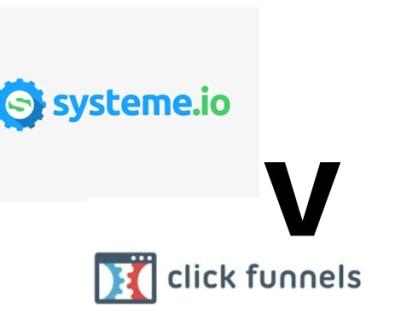
Here’s a comparison between Systeme.io and ClickFunnels across vario aspects like features, pricing, and user experience
Features:
Systeme.io offers a comprehensive suite of features providing tools for building websites, creating sales funnels, automating email campaigns, managing e-commerce, creating membership sites, creating courses, blogs and more.
ClickFunnels specializes in sales funnel building and optimization and primarily focused on helping users create high-converting sales funnels.
Pricing:
Systeme.io offers competitive pricing plans, including a free plan with limited features and paid plans starting at $27; a lower price point compared to ClickFunnels $127 basic plan price. Systeme.io’s paid plans offer additional features and functionalities, with tiered pricing based on the number of contacts.
ClickFunnels does not offer a free plan option except a 14 days trial.
Ease of Use:
Systeme.io features an intuitive interface and drag-and-drop builders, making it easy for users of all skill levels to create websites, sales funnels, and email campaigns. Guided tutorials and responsive customer support further enhance the user experience for beginners.
ClickFunnels also provides a user-friendly interface with a simple drag-and-drop editor for building funnels. However, some users may find ClickFunnels to be slightly more complex, especially when setting up advanced funnel configurations or integrations.
Integrations:
Both Systeme.io and Clickfunnels provide native integrations with popular third-party tools and platforms, including email marketing software, payment gateways, CRM systems, and webinar platforms. It also offers API access for custom integrations.
Customer Support:
Systeme.io offers responsive customer support via email, live chat, and a knowledge base. Users can access help articles, tutorials, and FAQs to troubleshoot issues or learn more about using the platform.
ClickFunnels provides customer support through email and a knowledge base. While ClickFunnels does not offer live chat support, users can submit tickets for assistance with technical issues or account inquiries.
Overall Value Proposition:
Systeme.io’s value proposition lies in its affordability, comprehensive feature set, user-friendly interface, and responsive customer support. It offers a more budget-friendly option for users looking to build and grow their online businesses without sacrificing functionality or usability.
ClickFunnels’ value proposition lies in its focus on sales funnel building and optimization. It excels in helping users create high-converting sales funnels, albeit at a higher price point compared to Systeme.io. ClickFunnels may be a better choice for users who need a more complex funnel performance and are willing to invest in a premium solution.
In conclusion, both Systeme.io and ClickFunnels offer powerful tools for building and optimizing sales funnels, but they cater to slightly different needs and preferences.
Systeme.io provides a more affordable and comprehensive solution with a focus on ease of use and customer support, while ClickFunnels specializes in funnel building and optimization with a higher price point. Users should consider their specific requirements and budget constraints when choosing between the two platforms.
Systeme.io V Kartra
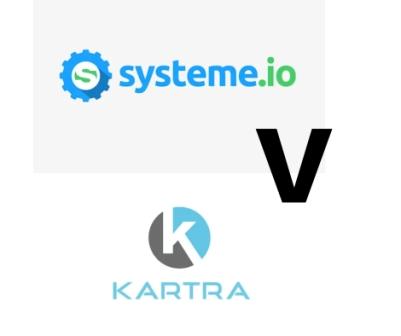
Here’s a comparison between Systeme.io and Kartra across various aspects:
Features:
Both Systeme.io and Kartra are an all-in-one marketing platform that provides similar features like website building, sales funnel creation, email marketing automation, membership site management, and affiliate program management etc.
Additionally, Kartra offers features such as video hosting, helpdesk ticketing and calendar scheduling.
Pricing:
Systeme.io offers competitive pricing plans, including a free plan with limited features. Systeme.io’s pricing makes it accessible to startups, solopreneurs, and small businesses with tight budgets.
Kartra’s pricing plans are higher ($119 starter plan) compared to Systeme.io $27 starter plan. While Kartra has no free plan except a 30 days free trial, its paid plans start at a higher price point and include additional fees for certain features or usage limits. Kartra’s pricing is more suitable for businesses with larger budgets or more extensive marketing needs.
Ease of Use:
Both Systeme.io and Kartra provide user-friendly interfaces with intuitive tools for building and managing marketing campaigns. However, some users may find Kartra to be slightly more complex, especially when setting up advanced automations or integrations. Kartra’s learning curve may be steeper for beginners compared to Systeme.io.
Integrations:
Systeme.io offers native integrations with popular third-party tools and platforms, including email marketing software, payment gateways, CRM systems, and webinar platforms. It also offers API access for custom integrations.
Kartra provides a wide range of integrations with third-party tools and platforms, including email marketing services, payment processors, membership site platforms, and more. Kartra’s extensive integration options make it suitable for businesses with complex tech stacks or specific integration requirements.
Customer Support:
Systeme.io offers responsive customer support via email, live chat, and a knowledge base. Users can access help articles, tutorials, and FAQs to troubleshoot issues or learn more about using the platform.
Kartra also provides customer support through email, live chat, and a knowledge base. Users can submit tickets for assistance with technical issues or account inquiries. Kartra’s customer support options are similar to Systeme.io’s, ensuring users can receive timely assistance when needed.
Overall Value Proposition:
Systeme.io’s value proposition lies in its affordability, comprehensive feature set, user-friendly interface, and responsive customer support.
It offers a budget-friendly option for users looking to build and grow their online businesses without sacrificing functionality or usability.
Kartra’s value proposition lies in its extensive feature set and integration options, making it suitable for businesses with more complex marketing needs.
In conclusion, both Systeme.io and Kartra offer powerful tools for building and managing online businesses, but they cater to slightly different needs and preferences.
Systeme.io provides a more affordable and user-friendly option with a focus on simplicity and accessibility, while Kartra offers a more comprehensive solution with extensive features and integration options. Users should consider their specific requirements and budget constraints when choosing between the two platforms.
In terms of value for money proposition, Systeme.io stands out for its affordability and comprehensive feature set. The platform offers a free plan option, making it accessible to users who are just starting or have limited budgets.
Additionally, Systeme.io’s paid plans provide excellent value with a wide range of features, including website building, sales funnel creation, email marketing automation, and more, at a fraction of the cost of its competitors.
Overall, Systeme.io’s pricing structure offers a compelling value proposition for users looking for an all-in-one solution for their online business needs. With its affordable pricing, comprehensive features, and flexible plans, Systeme.io is an attractive option for entrepreneurs and small businesses alike.
Conclusion
To wrap up, Systeme.io offers a comprehensive and affordable solution for small businesses and solopreneurs looking to establish and grow their online presence.
With its user-friendly interface, robust features, and responsive customer support, Systeme.io stands out as a top choice for those seeking an all-in-one platform for website building, sales funnel creation, email marketing automation, and more.
While larger enterprises may find Systeme.io suitable for certain use cases, its primary strength lies in catering to the needs of small businesses and individuals looking to succeed in the digital landscape.
Whether you’re a beginner or an experienced marketer, Systeme.io provides the tools and resources you need to thrive. Overall, Systeme.io earns high marks in our review for its affordability, functionality, and ease of use.
I hope this Systeme.io review helps you make a choice of the right marketing solution for your business.
FAQs
Systeme.io Pros and Cons based on real user reviews
Yes, you can migrate your existing website or sales funnel to Systeme.io. The Systeme.io support team will help you migrate helping you to seamlessly transition your online assets to their platform.
However, this is only available to paid users.
Yes, you can use Systeme.io to host webinars or online events. While Systeme.io does not have built-in webinar hosting capabilities like dedicated webinar platforms, it does offer features and integrations that allow you to create and promote webinars effectively.
Yes, Systeme.io provides analytics and reporting features to track the performance of your online business, including your website, sales funnels, email marketing campaigns, and more.
These analytics tools give you valuable insights into how your marketing efforts are performing and help you make data-driven decisions to optimize your strategies for success.
Here are some key analytics and reporting features offered by Systeme.io:
1.Website Analytics: Systeme.io provides website analytics to track key metrics such as website traffic, page views, unique visitors, bounce rate, and more.
These metrics give you insights into how users are interacting with your website and help you identify areas for improvement to enhance user experience and drive conversions.
2. Sales Funnel Analytics: With Systeme.io’s sales funnel analytics, you can track the performance of your sales funnels, including conversion rates, click-through rates, average order value, and more.
These metrics help you understand the effectiveness of your sales funnels and identify opportunities to optimize your funnel for higher conversions and sales.
3. Email Marketing Analytics: Systeme.io offers email marketing analytics to track the performance of your email campaigns, including open rates, click-through rates, conversion rates, and more.
These analytics help you measure the success of your email marketing efforts and optimize your campaigns for better engagement and results.
4. Conversion Tracking: Systeme.io allows you to set up conversion tracking to monitor specific actions or events on your website or sales funnels, such as form submissions, product purchases, or webinar registrations.
This helps you measure the effectiveness of your marketing campaigns and track the ROI of your efforts.
5. Custom Reporting: Systeme.io enables you to create custom reports and dashboards to visualize and analyze your data according to your specific needs and objectives.
You can customize your reports with various metrics, filters, and date ranges to gain deeper insights into your business performance and track progress towards your goals.
Overall, Systeme.io’s analytics and reporting features provide you with valuable insights into the performance of your online business, helping you make informed decisions and optimize your marketing strategies for success.
By leveraging these analytics tools, you can identify opportunities for growth, improve your marketing ROI, and drive business growth.
Yes, Systeme.io does have limits on the number of contacts or subscribers you can have on your email list, depending on the pricing plan you choose. Here’s a general overview of the contact limits for each plan:
Free Plan: The free plan of Systeme.io typically comes with a limit on the number of contacts or subscribers you can have on your email list which is 2000
Paid Plans: Systeme.io’s paid plans usually offer higher limits on the number of contacts or subscribers you can have on your email list compared to the free plan. The exact limit may vary depending on the specific pricing tier you choose, with higher-tier plans offering higher limits.
Yes, Systeme.io offers split testing, also known as A/B testing capabilities, to help users optimize their sales funnels and improve conversion rates. Split testing allows you to compare different versions of your sales funnel elements, such as headlines, call-to-action buttons, or page layouts, to determine which version performs better in terms of driving conversions.
Here’s how split testing works in Systeme.io:
1. Create Variations: Start by creating multiple variations of the element you want to test within your sales funnel. For example, if you’re testing a headline, you might create two different headlines to use in your split test.
2. Set Up Test: Once you’ve created your variations, you can set up a split test in Systeme.io’s dashboard. Specify the element you want to test and select the variations you want to compare.
3. Define Parameters: Define the parameters of your split test, including the duration of the test, the percentage of traffic to allocate to each variation, and the conversion goal you want to track (e.g., form submissions, purchases).
4. Monitor Results: Systeme.io will then automatically split your traffic between the different variations of your element and track the performance of each variation in real-time. You can monitor key metrics such as conversion rates, click-through rates, and revenue generated to determine which variation performs best.
5. Optimize Based on Results: Once your split test has concluded, analyze the results to identify the winning variation. Use the insights gained from the test to optimize your sales funnel and make data-driven decisions to improve conversion rates and overall performance.
By leveraging split testing capabilities in Systeme.io, you can systematically optimize your sales funnels and identify the most effective strategies for driving conversions.
This iterative process of testing and optimization can help you continuously improve your marketing efforts and achieve better results over time.
Yes, you can create upsells, downsells, and order bumps within your sales funnels on Systeme.io.
These advanced funnel features allow you to maximize your revenue and increase the average order value by offering additional products or services to your customers during the checkout process. Here’s how you can implement each of these features within your sales funnels on Systeme.io:
1. Upsells: An upsell is an offer made to customers to purchase a higher-priced or more premium version of the product they are already buying. In Systeme.io, you can create upsells by adding additional product offers or upgrades to your sales funnel sequence. When a customer completes a purchase, they will be presented with the opportunity to add the upsell product to their order before finalizing their purchase.
2. Downsells: A downsell is an offer made to customers who have declined or abandoned a previous upsell offer. In Systeme.io, you can create downsells by offering a lower-priced or alternative product to customers who have not accepted the initial upsell offer. This allows you to capture additional sales from customers who may be hesitant to purchase the upsell product.
3. Order Bumps: An order bump is a small, additional offer presented to customers on the checkout page, typically in the form of a checkbox or button. In Systeme.io, you can create order bumps by adding complementary or related products to the checkout page and allowing customers to add them to their order with a single click. Order bumps are designed to increase impulse purchases and boost the average order value.
By leveraging upsells, downsells, and order bumps within your sales funnels on Systeme.io, you can optimize your conversion rates and maximize the revenue generated from each customer transaction. These advanced funnel features allow you to provide additional value to your customers while increasing your profitability and growing your online business.
No, Systeme.io does not have a dedicated mobile app yet for managing campaigns and tracking performance on the go.
However, Systeme.io’s platform is mobile-responsive, meaning you can access and use it on your mobile device’s web browser.
While you may not have access to the full functionality of the desktop version, you can still perform many essential tasks on the mobile version of Systeme.io, such as:
- Checking campaign performance metrics.
- Sending emails to your subscribers.
- Managing contacts and leads.
- Creating and editing sales funnels.
- Accessing support and help resources.
Yes, Systeme.io provides training and resources to help users maximize their use of the platform and achieve their business goals. Here are some of the training and resources offered by Systeme.io:
Knowledge Base: Systeme.io offers a comprehensive knowledge base that contains articles, tutorials, and step-by-step guides on how to use the platform’s features and functionalities effectively. Users can access the knowledge base to find answers to common questions, troubleshoot issues, and learn best practices for using Systeme.io.
No, Systeme.io does not offer a white-label option specifically for agencies or resellers.
Systeme.io does not explicitly state any restrictions on the type of content or products that can be promoted using their platform.
However, like most online marketing and sales platforms, Systeme.io has guidelines and policies in place to ensure that users adhere to legal and ethical standards when promoting content or products.
Yes, Systeme.io offers built-in SEO features to help users optimize their websites for search engines and improve their visibility in search engine results pages (SERPs). While Systeme.io primarily focuses on sales funnels and marketing automation, it includes several SEO tools and functionalities to enhance website optimization.
Here are some of the built-in SEO features offered by Systeme.io:
SEO-Friendly URLs: Systeme.io allows users to create custom, SEO-friendly URLs for their web pages, blog posts, and sales funnel steps. By optimizing URLs with relevant keywords and descriptive phrases, users can improve their chances of ranking higher in search engine results.
Meta Tags Optimization: Users can customize meta tags, including meta titles, meta descriptions, and meta keywords, for each web page, blog post, and sales funnel step. Optimizing meta tags with targeted keywords and compelling descriptions helps search engines understand the content of the page and encourages users to click through to the site.
Image Optimization: Systeme.io includes tools for optimizing images uploaded to the platform. Users can add descriptive alt text, titles, and captions to images to improve accessibility and provide context to search engines, ultimately enhancing the website’s overall SEO performance.
XML Sitemap Generation: Systeme.io automatically generates XML sitemaps for websites hosted on the platform. XML sitemaps help search engines crawl and index website content more efficiently, ensuring that all pages are discovered and ranked appropriately in search results.
Mobile Responsiveness: Systeme.io’s website templates are designed to be mobile-responsive, ensuring that websites display properly and function smoothly on various devices and screen sizes. Mobile responsiveness is a crucial factor in SEO, as search engines prioritize mobile-friendly websites in their rankings.
Page Speed Optimization: Systeme.io prioritizes fast-loading web pages, which is essential for SEO performance. Faster loading times improve user experience and reduce bounce rates, signaling to search engines that the website is high-quality and valuable to users.
While Systeme.io’s primary focus is on sales funnel creation and marketing automation, its built-in SEO features provide users with the tools and functionalities they need to optimize their websites for search engines effectively.
Yes, you can import and export your data and contacts easily from/to other platforms using Systeme.io. Systeme.io provides tools and functionalities to facilitate the transfer of data between its platform and other systems, allowing you to seamlessly integrate your existing contacts and information into Systeme.io and vice versa. Here’s how you can import and export data and contacts with Systeme.io:
Import Contacts: Systeme.io allows you to import contacts from external sources such as CSV files, Excel spreadsheets, or other email marketing platforms. You can use the import feature within Systeme.io’s dashboard to upload your contact list and add them to your email marketing lists or CRM database.
Export Contacts: Similarly, Systeme.io enables you to export your contacts from its platform to external sources for backup or integration purposes. You can export your contact list as a CSV file or Excel spreadsheet from Systeme.io’s dashboard and then import it into other systems or tools as needed.
Integration with Third-Party Platforms: Systeme.io integrates with various third-party platforms and services, including email marketing providers, CRM systems, payment gateways, and more. These integrations allow you to sync your data and contacts between Systeme.io and other platforms seamlessly, eliminating the need for manual import/export processes.
API Access: Systeme.io provides API access, allowing you to programmatically interact with the platform and automate data transfer processes between Systeme.io and other systems. With API access, you can build custom integrations and workflows to sync data and contacts in real-time, ensuring consistency and accuracy across multiple platforms.
Systeme.io does not offer built-in support for creating multi-language websites and funnels. However, you can still create multi-language content by using workarounds and third-party integrations.
Here are some ways you can create multi-language websites and funnels with Systeme.io:
Duplicate Funnels: Create separate funnels for each language you want to support. Customize the content, text, and images in each funnel to match the language preferences of your target audience.
Use Subdomains or Subdirectories: Set up subdomains or subdirectories for each language version of your website. For example, you can create “en.yourwebsite.com” for English and “fr.yourwebsite.com” for French. Then, create separate funnels for each language and link them to the corresponding subdomains or subdirectories.
Third-Party Translation Tools: Use third-party translation tools or services to translate your website content into multiple languages. Once translated, you can manually add the translated content to your Systeme.io funnels.
Custom Code Integration: If you have coding knowledge, you can use custom code integration to implement multi-language functionality on your Systeme.io website. This may involve using JavaScript or other programming languages to detect the user’s language preference and display the appropriate content dynamically.
Systeme.io allows you to connect only one costume domain on its free plan. if you want to connect more domains, you will need to upgrade to a paid plan.
Yes, you can
No, Systeme.io offers unlimited storage and bandwidth on all plans

Masters of Scale Handcrafted Review
Podcast Notes: Masters of Scale Handcrafted Review
Ever wonder how a tiny startup with air mattresses in a living room became one of the biggest travel companies in the world?
It wasn’t luck. It was handcrafted.
In this unforgettable episode of Masters of Scale, Airbnb co-founder Brian Chesky spills the secrets of their early days—the scrappy hustle, the endless customer calls, and the “no detail is too small” approach that turned sceptics into super-fans.
This isn’t just a podcast episode; it’s a masterclass in getting up close and personal with your customers and turning their feedback into magic.
If you’ve ever dreamed of building something extraordinary, trust me—you need to read this.
Dive in, soak up the lessons, and who knows? You might just uncover the blueprint for your next big idea.
About Masters of Scale
Masters of Scale is a podcast hosted by Reid Hoffman – the legendary Silicon Valley entrepreneur and investor (Co-founder of Linked) which explains how founders take their companies from zero to gazillion.
How to design products that sell, From idea to launch and then scale

At the heart of this captivating narrative lies the profound understanding that success is not merely about building a product or service, but about crafting an experience that resonates deeply with users.
Chesky’s revelation that “if you want to create something that’s truly new, you have to pull the future forward” serves as a guiding beacon for aspiring entrepreneurs, urging them to embrace disruption and challenge the status quo.
In order to scale, you have to first do things that don’t scale
Brian Chesky Tweet
About AirBnB
The company at the centre of this episode is AirBnB. AirBnB is the short form of Airbedandbreakfast.com.
AirBnB is based in San Francisco California and operates an online marketplace focused on short term home stays and trip experiences.
The company acts as a broker and collects commissions from each booking.
They are in the end to end business of travelling.
AirBnB was founded in 2008 by Brian Chesky, Nathan Blecharczyk and Joe Gebbia with Chesky as its CEO.
AirBnB is valued at $113B as at 2021

Want to Start Making Consistent Sales in Your Business?
Gain access to our FREE customer acquisition guide
Explanation of some words used in Masters of Scale Podcast:
Scale – Scaling does not mean to grow. It means to grow exponentially. A company is said to have achieved growth when it adds new resources (capital, people or technology) and its revenue increases as a result.
For a company to achieve growth, it must spend money on adding new resources. A business is said to have achieved scale when revenue increases without a substantial increase in resources if any at all.
Let’s hear from Brian Chesky of AirBnB on Handcrafting a product

In order to scale, you have to first do things that don’t scale. The only way an organization or a business would scale is to start with doing things that don’t scale at all like handcrafting the whole process (doing everything with hands or manually.)
Reid Hoffman has worked with and invested in companies that scaled to 100m users or more.
He said, “when you are just starting, you don’t start with 100m users. You start with a few. So, stop thinking big and start thinking small. Reach out to your customers and win them over one by one”
This may sound odd if you are an entrepreneur with a global ambition.
For example, Mark Zuckerberg did not build Facebook, invite 1.1 billion people to Facebook and users just poured in. That’s not how it happened. Here is how it works.
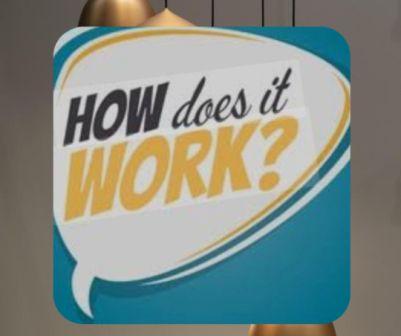
Here is how it works
When designing a product, you have to put yourself in the shoes of the user you are designing the product for.
You must design your product with empathy for a single user. Imagine being your product’s user. Put yourself in her shoes.
If you are designing your product with only A/B test, you are not designing with empathy.
Most times, startups are thinking how to grow big from day one. They have promised the investor millions and millions of users and they need to deliver.
They start from the end instead of starting from the beginning and going upwards. It’s like building a skyscraper on a faulty foundation.
Brian goes further to say, “You have to handcraft the user experience before you scale”.
The foundation is the user experience. It’s the user experience you handcrafted that you scale to reach more people.
Once you start having a few users, go to your users or customers one by one, try to know them.
Going to the users one by one is not scalable, but it’s highly necessary if you plan to scale. This is the only time you have to do this because once you scale your product; you won’t have the time to go to them.
So, now that you are small, go to your customers, get to know them, what they want and create the product for them.
When AirBnB was having little traction or a few users of their marketplace, they visited their customers at home one by one and offered to professionally photograph their homes and list it for them.
This became AirBnB’s secret weapon because that’s how they learnt what people (their users) loved.
It’s not easy to get 10 people to love anything, but it’s not hard when you spend time with them and find out what they really want.
You get to ask questions like, what if I do this or that.
From the answers to these questions, a handcrafted experience is born.
For example, AirBnB while asking these kind of questions, they found out “ what if I am not comfortable with the guest? So, they provided a solution by profiling the guests. They also found out what the users would love to be in the profile. They wanted the names, photos of the guests, where they live and work etc.
This kind of information helps you to start designing the product touch point by touch point.
The road map always exists in the minds of the users you design the product for.
Let the user show you the road map in their minds for your product.
You can get very detailed feedback from your early users.
Recommended: Summary of The Empire of Business by Andrew Carnegie
What are users saying about your product?

According to Brian Chesky, “if you are not getting people who are saying, ‘this is super important to me, I love this, I will really love this to work;’ it usually means you are off track and you need to go back to the drawing board”
Passionate feedback is a clue that your product really matters to someone and one passionate user can turn into many if you listen to them carefully.
It’s important to get this kind of feedback early. It’s like setting the foundation as an architect. You should not build a skyscraper before building a solid foundation. User feedback makes sure you don’t build 1000 users on unstable swamp.
How to get the right feedback

To get the right feedback from users, this is what Brian does:
- He does not ask for the product he just built, he asks for the product of your dreams. He asks these kind of questions:
What could we do not to make this product better, but to make you tell everyone about it? The answer to this question is different. It makes you to think “what will it take me to design a product that you will literally tell everyone about.”
Listen to user’s feedback, but the caveat is, you have to know which of your users to listen to.
You have to be able to know which users will take you in the right direction (mass market and your vision).
If you want to create something that would go viral, you must create a mind blowing end to end experience that people would like to tell everyone about.
AirBnB took one part of their product and created a five star experience and people went crazy.
If you want to create something that would go viral, you must create a mind blowing end to end experience that people would like to tell everyone about.
Two steps to create a perfect product

According to Brian Chesky, to create a perfect product, do these:
- Create a perfect experience
- Then scale that experience
AirBnB did not guess what the users want; they reacted to what the users wanted and asked for and then made a piece meal progress.
They didn’t launch perfectly scaled services. They built everything by hand and then scaled it with the right technology, processes, people, and partners.
Once a startup has proven that it has a product that people want, (product market fit) it’s time to take that product to the masses.
The crude art of doing things that don’t scale is a way to start a successful business on string budget and it also gives inspiration to your team to create the right product.
How to move from the handcrafted stage to the scaling stage
Handcrafting a product is one of the most creative times for founders. Brain says,” the transition from the handcrafting stage to the scaling stage is very challenging.
In fact, it needs two opposing mindsets. You can’t switch from one to the other with ease.”
You have to be able to empathize with a single user and at the same time, worry about everyone (mass market).
The designing phase is done with another side of the brain than the scaling experience. You need different skill sets for each. The designing experience is creative, intuition based, human and end to end experience. It’s more like writing.
The scaling phase is more analytical. It’s like being an editor. You do a lot of pruning. You prune, compact and distil so you can now run at a rocket ship rate. You focus on the 20% of users to get the 80%.
You transition your product to scale the organization to run it. All you need is a simple plan and little proposition.
Designing an ideal experience does not drop away as soon as your product goes viral. Handcrafting a product is a kind of booster that helps you get in the orbit, but it’s not the kind of rocket for the whole trajectory.
Handcrafting gets you out of the gravity well and after that, get ready for the main work.
Sharper founders never throw away the handcrafted mindset no matter how big their organization becomes.
As a founder, you need to be careful which part of the organization to scale and you must protect the handcrafting of new things in your company because the natural reaction of a scaled organization is to kill it (handcrafted products) because they would believe that they won’t be able to get it to scale.
How to re-invent or disrupt an industry

To re-invent an industry, you do not take inspiration from that industry. You need to look at other industries that have what you want to add to your industry.
For them at AirBnB, they got inspiration from the end to end travel experience portrayed in the cinema industry. “The best trips you have ever seen, is the trips that movie characters have,” says Brian
Brian wanted to create and scale a perfect trip. To do that, he switched back to creating a perfect trip for one individual.
He designed an end to end travel experience for one person who was wowed and that became a blue print for them.
Next, he asked his team,” can we develop the technology to replicate it 100m times?
Now he switches to the analytical mindset to scale the product.
They started with a small group of users and used years to figure out how to scale that experience. This has led to what is called the AirBnB Trips.
The less your products changes, the bigger you will get. So, you have time when you are small to make all the changes you need.
Take advantage of the sub scale experience to design a perfect experience.
Dream big, act small. Be passionate about your users, handcraft the core service for them, create a magical experience and then figure out what part of that magical experience you can scale.
Create a wow or 5 star experience for one user and then look for the technology to scale it to the mass market.
Take advantage of the sub scale experience to design a perfect experience.
Conclusion
In conclusion, the Masters of Scale Handcrafted review featuring Brian Chesky of Airbnb offers a masterclass in entrepreneurial prowess.
Chesky’s profound insights into the delicate balance between handcrafting a product and scaling it to global proportions shows that this is doable as long as you focus on the end users of your product.
As he aptly puts it, “the key lies in crafting an experience that is deeply rooted in authenticity and human connection, while simultaneously harnessing the power of scale to amplify its impact”.

Zobo drink Goldmine: Your Complete Guide for a Successful Zobo Drink Business
Want to Start Making Consistent Sales in Your Zobo Business?
Gain access to our FREE customer acquisition guide
How to make zobo drink for sale
Table of Contents
Why you need to start zobo drink business today
Think of Zobo drink as Your Treasure Chest:
Low startup cost, big profit
Increase in demand and trends due to:
- Rising Health Consciousness. The global trend towards healthier beverage choices has contributed to increased demand for Zobo drink. Consumers are seeking natural and nutritious alternatives to sugary and artificial drinks.
- African and Diaspora Markets. Zobo is a staple in many African countries and among African diaspora communities worldwide. The demand for Zobo is consistently strong in these regions due to its cultural significance.
- Growth in Natural and Organic Beverages. As people become more health-conscious, there is a growing preference for natural and organic beverages. Zobo, made from hibiscus petals and other natural ingredients, fits this trend.
Expansion of Ethnic Food and Beverage Markets.
Zobo drink has gained popularity in markets with diverse ethnic populations. Ethnic food stores and restaurants often offer Zobo to cater to the tastes of their customer.

What you need to know about zobo drink
What is zobo drink?
Want to Start Making Consistent Sales in Zobo Your Business?
Gain access to our FREE customer acquisition guide
Zobo drink health benefits
- Blood Pressure Regulation: Zobo drink or hibiscus tea boasts of anti hypertensive properties that actively work to lower or control high blood pressure.
-
Takes care of your liver: Scientific studies reveal that zobo drink consumption contributes to fighting liver damage and serves as a safeguard against liver diseases.
-
Helps digestion: Embracing zobo drink can enhances digestion through the stimulation of stomach acid production, alleviating gut inflammation, and providing gentle, natural relief for constipation.
-
Antioxidants power house: Packed with antioxidants, zobo drink acts as a shield, safeguarding your cells against free radical damage, thus reducing the risk of chronic illnesses.
-
Strengthens your immune system: Rich in vitamin C and other nutrients, hibiscus tea lends a hand in fortifying your immune system, aiding in the battle against infections.
-
Anti-Inflammatory Elixir: Zobo drink’s anti-inflammatory properties offer widespread relief by reducing inflammation throughout the body.
-
Weight Management Ally: Zobo drink proves to be a valuable companion in weight loss endeavours by curbing body fat, suppressing appetite, and fostering a sense of fullness.
-
Blood Sugar Regulation: Zobo drink can regulate blood sugar levels by diminishing insulin resistance and enhancing glucose metabolism.
-
Mood Enhancement: Experience a sense of calm and reduced stress with the potential mood-boosting effects of Zobo drink.
-
Glowing Skin: The generous antioxidant content in zobo drink contributes to skin health and fights signs of aging.
-
Heart Health Promotion: Your heart will thank you as drinking zobo tea helps reduce blood pressure, lower cholesterol levels, and mitigate the risk of heart disease.
-
Sharpens your brain: Scientific investigations suggest that zobo drink could sharpen cognitive functions, including memory and concentration.
-
Menstrual Pain Relief: Find relief from menstrual discomfort with zobo drink’s ability to ease inflammation and serve as a natural pain reliever.
-
Respiratory Wellness: Amplify respiratory health with zobo drink’s vitamin C content, known for reducing inflammation and combating infections.
-
Cancer Risk Reduction: Preliminary research indicates that hibiscus tea’s substantial antioxidant content may lower the risk of specific types of cancer.
Want to Start Making Consistent Sales in Your Zobo Business?
Gain access to our FREE customer acquisition guide
Marketing and branding
Expansion
Is zobo drink business profitable?

- Cost of production. The cost of ingredients, labour, packaging, and overhead expenses will impact profitability. Purchasing ingredients in bulk can help reduce costs.
-
Pricing strategy. Setting the right price for your Zobo drink is crucial. It should cover your costs and leave room for profit while remaining competitive in your market. Prices can vary widely, but let’s assume you sell a bottle of Zobo for ₦200 per 35cl bottle (this is its current price in some locations like Lagos) and that your cost of producing one bottle is ₦150.
-
Sales volume. The number of Zobo drinks you sell daily, weekly, or monthly plays a significant role. If you sell 100 bottles per day, that’s ₦200,000 in daily revenue, before expenses. If you are making ₦50 per bottle, that is 100 x 50 = ₦5,000 profit daily.
- Location. Operating in high-traffic areas or markets with strong Zobo demand can increase sales and profitability.
- Operational efficiency. Reducing wastage, optimizing production processes, and minimizing overhead costs can improve profitability.
Ingredients and equipments for zobo drink production
Raw materials for zobo drink production (ingredients needed for Zobo drink) :
- Hibiscus flower (zobo leaves): This is the primary ingredient that gives zobo drink its tart flavour and red colour
- Water: This is used as the base for brewing the concentrate
- Cloves: Used for flavour and as natural preservative
- Cinnamon sticks: Used for its flavour
- Ginger: This is grated and added to the mix
- Lemon: Used for its flavour and nutrients (optional)
- Lime: Used for its flavour, nutrients and as natural preservative (optional
- Pineapple: Used for its flavour and nutrients
- Sweetners: Common sweetners like sugar, or natural sweetners like dates, honey can be used. The amount depends on your preferred level of sweetness, but a typical ratio is 1 to 2 cups of sugar per liter of water.
- Preservative (sodium benzoate). Helps it to last upto 28 days outside the refridgerator and 2 months inside the refrigrator.
Zobo drink making equipments and supplies
To start a Zobo production business, you will need various equipment for the production process. Here’s a list of the essential equipment you will require:
- Large Pots or Boilers: These are used for brewing the Zobo concentrate. You will need at least one large pot, preferably made of stainless steel, with a capacity of 20-50 liters or more, depending on your production scale.
- Strainers or Sieves: These are essential for separating the Zobo concentrate from the hibiscus petals and other ingredients. Multiple sizes of strainers may be required to ensure their is no particle in the final zobo drink.
Blenders or Grinders or mortars: You will need blenders or grinders or mortars to break down spices, ginger, and other flavoring ingredients to ensure they mix well with the Zobo concentrate. - Bucket Containers with tap to fill the zobo concentrates in bottles. Ensure these containers have a tight lid to stop the concentrate from being contaminated. You will need at least one which will cost around ₦5000
- Bottles for packaging the final Zobo product. These should come in various sizes, such as 35cl, 50cl, or 1 liter, depending on your target market. Cost of bottles range from ₦30 -₦100 per bottle depending on the size and your area.
- Product label: Print your product label. Professional labels make your product look more appealing and informative.
- Heat gun and packaging nylon for packing the drinks in cartons. Heat gun helps you to seal your products in cartons. The cost of heat gun is around ₦15,000. Price may vary depending on your location.
- Stirring Utensils: Long-handled stirring utensils, such as ladles or paddles, are necessary for stirring the Zobo concentrate during the brewing process.
- Measuring Cups and Spoons: You will need these for accurate measurements of ingredients to ensure consistent product quality.
- Heat Source: Depending on your production scale, you may require a heat source, such as a gas burner or electric stovetop, to brew the Zobo concentrate in large pots.
- Water Source: Ensure you have access to clean water for various stages of production, from washing ingredients to cleaning equipment.
- Quality Control Equipment: To maintain consistent product quality, you may need equipment for pH testing, sugar content measurement, and other quality control measures. This is optional. Ensure you cover the zobo concentrate to avoid contamination.
- Cleaning Supplies: Stock up on cleaning supplies such as brushes, detergents, and sanitizing agents to maintain hygiene in your production area.
- Storage Racks and Shelves: These are essential for organizing ingredients and packaging materials, as well as for storing finished products.
- Safety Gear: Ensure you and your staff have necessary safety gear, including aprons, gloves, and hair nets to maintain hygiene and safety during production.
- Utensil Washing Area: Set up a designated area for washing utensils and equipment to maintain cleanliness in your production space. Your kitcken sink is perfect for this if you are producing from your house.
The specific equipment you need may vary based on your production scale and the complexity of your Zobo recipe. It’s essential to maintain strict hygiene standards and adhere to food safety regulations throughout the production process.
How to get a standard equipment to process zobo drink in large quantity
Zobo drink recipes and production process
Recipe for large scale zobo production
- 3 1/2 custard buckets or 13kg of dried zobo leaves (broken leaves).The broken leaves yeild more than the unbroken (whole) leaves and they are also more expensive than the unbroken zobo leaves.
- 10 big pineapples (peeled and cut into pieces)
- 250g of fresh ginger (blended)
- 200 liters of water
200g of clove - 5kg of sugar (adjust to taste) or 6kg of dates if you want to make zero sugar zobo drink.
- 10 pieces of lime (cut in pieces)
- 4 sticks of cinnamon (ground into powder)
- 30g of sodium benzoate and 50g of potassium sorbate for preservation mixed in 200ml water.
How to process your zobo drink
To process your zobo drink or hibiscus tea, do the following:
- Wash the zobo leaves. While washing, some colours will go out. Don’t bother about that as the zobo leaves or petals are rich in colour.
- Wash the back of the pineapples preferably scrub them under running water with a brush as you are going to use the peel as part of your ingredients. Once you are done watching it, cut it and put the peels aside for later use. Cut the pineapple into pieces and use a juicer to bring out the juice. If you don’t have a juicer, use blender. Once you are done blending it, use a strainer to separate the pulp from the juice and set it aside. Also keep the pulp separately.
- If you want to use dates as sweetner, wash the dates and soak in water over night if they are dried dates. Once they are soft, remove the seeds and blend them with blender until they become smooth and turn to paste. Set it aside.
- Wash and blend your ginger. Set it aside.
- Wash your lime and lemon and cut them in pieces with their backs intact.
- Wash your cloves and blend them too.
- Set your pot on the fire. Pour water, add the pineapple peel and pulp, cloves, ginger, and the dried zobo leaves and cook for 30 minutes. Once done, pour out the zobo concentrate into another container, add water again to the leaves in the pot, cook again for 15 minutes. Repeat this until you get your 200 litres of zobo. You can do this upto 3 times to ensure you get all the redness out of the zobo leaves. Allow to cool down to room temperature. Pour the pineapple juice and the dates into the zobo concentrate and stir well. Then strain the zobo concentrate again to ensure there are no particles in it. Pour it into your dispensing tank or bucket with tap and pour into PET bottles for sale. If you are using sugar instead to sweeten it, add the sugar instead of dates.
- If you don’t want to use natural pineapple juice to flavour it, use pineapple flavour like Fresh or Viva pineapple powder flavour and add to taste.
Want to Start Making Consistent Sales in Your Zobo Business?
Gain access to our FREE customer acquisition guide
Zobo drink cucumber flavour recipe
What is the best preservative for zobo drink?
Zobo drink branding and packaging

Eye-Catching Labels and Packaging
Clear branding
Product Information
Use unique bottles
If possible, use unique bottle or container shapes to make your Zobo drinks stand out on the shelves. Unconventional packaging can be a great conversation starter.
Don’t use used PET bottles if you plan to stand out.
Customise it
Offer customization options, such as personalized labels or bottle sizes, for special events like weddings or corporate functions. Personalization can attract customers looking for unique gifts or event favors.
Tell your story
Use your packaging to tell the story of your Zobo business. Share your journey, your commitment to quality, and any unique aspects of your production process that set you apart from competitors.
Loyalty programs
Incorporate loyalty program details on your packaging, such as QR codes that customers can scan to sign up for discounts or rewards. This encourages repeat business.
Seasonal Packagings
Consider seasonal packaging for special occasions like holidays or local festivals. These limited-time packages can create a sense of urgency and excitement among customers.
High quality labels
Ensure that your labels are professionally printed, adhere well to the bottles, and are resistant to smudging or fading.
Interactive packaging
Incorporate interactive elements, like contests, puzzles, or QR codes leading to online content or promotions. This engages customers and encourages them to interact with your brand.
Health and nutritional claims
Highlight zobo health benefits on your packaging. En to make people know they would live a healthier life drinking zobo or hibiscus tea.
Consistency
Visibility
Place your products in high-traffic areas or use creative in-store displays to ensure visibility. Eye-catching packaging is only effective if it’s seen by potential customers.
Customer feedback
Zobo drink business plan template
How to get names for your zobo business
Zobo drink business marketing and sales strategies
High quality product
Target audience
Branding
Pricing strategy
Marketing Campaigns
Partnerships
Customer reviews and testimonials
Loyalty programs
Event sponsorship
Customer engagement
Seasonal promotions
Market research
Product development and innovation
customer segmentation
Localized marketing
Online sales and delivery
Referral program
Sampling events
Email marketing campaigns
Build an email list and send regular newsletters with updates, promotions, and exclusive offers to keep customers engaged.
Sustainability efforts
Educational content marketing
Want to Start Making Consistent Sales in Your Zobo Business?
Gain access to our FREE customer acquisition guide
Distribution and sales of zobo drink
Local markets
Set up a stall or booth at local markets, where you can attract a wide range of customers, including shoppers and passersby.
Street vending
Community events
Catering Services
Offer catering services for local parties, weddings, and corporate events. Provide Zobo drinks as part of your catering packages. You can also partner with event planners to add your drinks to the menu. This will help you sell more.
Local retail stores
Local Restaurants and Cafes
Mobile Carts or Kiosks
Use mobile carts or kiosks in strategic locations, such as near offices, schools, or public transportation hubs.
Schools and Colleges
Sports events
Churches and Religious Gatherings
Corporate Offices
Hospitals and Clinics
Word of Mouth
Here are places to sell zobo online
Your Own E-commerce Website
Social Media Platforms
Online marketplaces
Food delivery Apps
Subscription Box Services
Local Directories
Review Websites
Online advertising
Food Bloggers and Influencers
Video marketing
Local Online Forums and Groups
WhatsApp business
Online payment systems
Google Shopping
Legal requirements and permits
for starting a zobo drink business
- Business Registration: Register your Zobo business as a legal entity. You can choose to register as a sole proprietorship, partnership, limited liability company (LLC). Registering your business enables you to open a corporate bank account for your business which also helps for branding. Without registering your business with Corporate Affairs Commission (CAC) if you are in Nigeria, you will not be able to register your product with the National Agency for Food and Drug Administration and Control (NAFDAC) which is necessary if you want to be able to sell your products in big supermarkets. You can register your business with the CAC here.
- Food Safety Standards: Register and adhere to food safety standards and guidelines set by the National Agency for Food and Drug Administration and Control (NAFDAC) and the Standards Organisation of Nigeria (SON). Comply with their regulations for food production, labelling, and packaging.
- Premises and Equipment: Ensure your production facility and equipment meet hygiene and safety standards. Your premises should be inspected and approved by relevant health authorities.
- Quality Control: Implement quality control measures to maintain the consistency and quality of your Zobo drinks. Regularly test your products for safety and quality.
- Taxation: Register for tax purposes and fulfill your tax obligations, including Value Added Tax (VAT) and other applicable taxes.
- Insurance: Consider insurance coverage, such as product liability insurance, to protect your business from potential legal claims.
- Employment Laws: If you plan to hire employees, understand and comply with Nigerian labour laws or the law of the country where your business is situated, including minimum wage requirements and employment contracts.
- Trademark and Intellectual Property: If you plan to create a unique brand or product name, consider trademark registration to protect your intellectual property. To be able to register your zobo drink business with NAFDAC and SON, you will need to also have registered your trademarks. You can register your Trademarks here
It’s essential to consult with a legal adviser or business consultant who is familiar with the regulations and legal requirements for food and beverage businesses in Nigeria. The specific requirements can vary by location and may change over time, so staying informed and up-to-date is crucial to operating your Zobo business legally and successfully.
Cashflow management for your zobo drink business
Breakdown cost for starting large scale zobo drink production
- Business Registration and Licensing permits: Expect to spend approximately ₦105,000 to ₦180,000 for business registration,Trademarks and NAFDAC registration if you are in Nigeria. If you are in another country, find out the cost for business registration and the cost of obtaining the necessary permits
- Production Equipment: Allocate ₦50,000 to ₦200,000 for the purchase of essential equipment.
- Ingredients and Raw Materials: Initial inventory costs for ingredients could be ₦70,000 to ₦350,000
- Packaging Materials: Budget approximately ₦30,000 to ₦100,000 for initial packaging supplies.
- Transportation and Delivery: Anticipate transportation costs of ₦40,000 to ₦80,000.
- Marketing: Allocate ₦60,000 to ₦200,000 for marketing expenses.
- Utilities and Insurance: Plan for monthly costs of ₦20,000 to ₦40,000 for utilities and insurance.
- Initial Working Capital: Ensure you have enough working capital to cover day-to-day expenses, with a budget of ₦50,000 to ₦100,000 for the first few months.
Total Estimated Startup Costs:
The total estimated startup costs for a small-scale Zobo drink business in Nigerian Naira can range from ₦335 to ₦1,250,000. Please keep in mind that these are rough estimates and that actual costs can vary based on location, specific business choices, and the scale of your operation.
Want to Start Making Consistent Sales in Your Zobo Business?
Gain access to our FREE customer acquisition guide
Setting Pricing for your zobo drink business
If you are wondering how to price your zobo drink product to maximize profit, here is how to set competitive prices:
- Cost Analysis: Calculate your production costs, including ingredients, packaging, labour, utilities, and overhead. This will be your baseline cost.
- Competitor Research: Study your competitors in the Zobo drink market. Identify their pricing strategies, portion sizes, and any unique selling points.
- Market Research: Understand your target market and their price sensitivity. Conduct surveys or interviews to gather insights into what customers are willing to pay for Zobo drinks.
- Positioning: Determine where you want your Zobo brand to stand in the market. Are you offering premium, mid-range, or budget Zobo drinks? Your pricing should align with your brand positioning.
- Profit Margin: Decide on the profit margin you want to achieve. Consider industry standards and your business goals.
- Choose a pricing strategy: Use Cost-Plus Pricing strategy (add a markup [e.g., 30%] to your production cost), competitive Pricing (match or slightly undercut your competitors’ prices), Value-Based Pricing ( set price based on the perceived value your Zobo offers), Penetration Pricing (set lower initial prices to gain market share), Bundle Pricing (offer discounts for combo deals) or dynamic Pricing (adjust prices based on demand, time of day, or seasons) etc.
- Pricing Tiers: Consider offering different Zobo drink sizes or flavours at various price points to cater to a wider customer base. You should offer something like 35cl, 50cl and even 1 litre and in different flavours too.
- Promotions and Discounts: Use limited-time promotions or discounts strategically to attract new customers or encourage repeat business.
- Sustainability: Ensure that your pricing is sustainable in the long term, accounting for changes in ingredient costs and market conditions so you won’t need to change your prices again too quickly.
- Testing: Start with your initial pricing strategy, but be prepared to adjust it based on customer feedback and market response. Monitor sales and customer reactions to your pricing.
- Transparency: Be transparent about your pricing. Make sure customers understand what they are paying for and why your Zobo is priced the way it is. Highlight quality, unique flavours, or other value propositions.
- Cost Reduction: Look for ways to reduce production costs without compromising quality. This can help you maintain competitive pricing.
- Feedback Loop: Continuously gather feedback from customers regarding your pricing and product. Adjust your pricing strategy accordingly.
- Monitor the Competition: Stay updated on your competitors’ pricing and adapt as needed to maintain your competitive edge.
- Local Market Considerations: Factor in local economic conditions and income levels when setting prices, especially if you have a local customer base.
Setting competitive prices is an ongoing process. Regularly review and adjust your pricing strategy to stay competitive, meet customer demands, and ensure a healthy profit margin for your Zobo drink business.a
Zobo drink business challenges and tips for success
Here is how to excel in zobo business
- Smart Ingredient Purchases: To increase your profits, consider buying your raw ingredients in bulk when preparing for production.
- Prioritize Taste: The taste of your Zobo drink is crucial. Think about a time you tried something that didn’t taste good; it’s not fun. For instance, I once had a scotch egg with a nearly rotten egg inside, and it was definitely not a pleasant experience. To avoid this, make sure you use the right proportions of all essential ingredients to ensure your Zobo drink tastes delicious.
- Hygiene is Vital: Cleanliness and hygiene are super important. Nobody wants to consume something that might make them sick. People will steer clear of any drink that causes stomach problems or contains dirt particles. If someone tries your product and it leaves them feeling satisfied and healthy, you’re likely to gain a loyal customer. Make sure you prioritize cleanliness in your production process. By the way, avoid using saccharine instead of sweetener in your Zobo; it’s not a good substitute.
- Consistency Counts: Don’t start making a delightful Zobo drink today and then stop tomorrow. Likewise, don’t compromise on quality by diluting your drinks with water just to increase your supply. Consistency, both in terms of quality and quantity, is key to building a strong customer base and growing your Zobo business.
Conclusion
Want to Start Making Consistent Sales in Your Zobo Business?
Gain access to our FREE customer acquisition guide
-
Story Audio September 1, 2025
-
Atom Audio September 1, 2025
-
User P Audio September 1, 2025
-
POC Audio July 18, 2025
-
SB Worksheet July 14, 2025

